
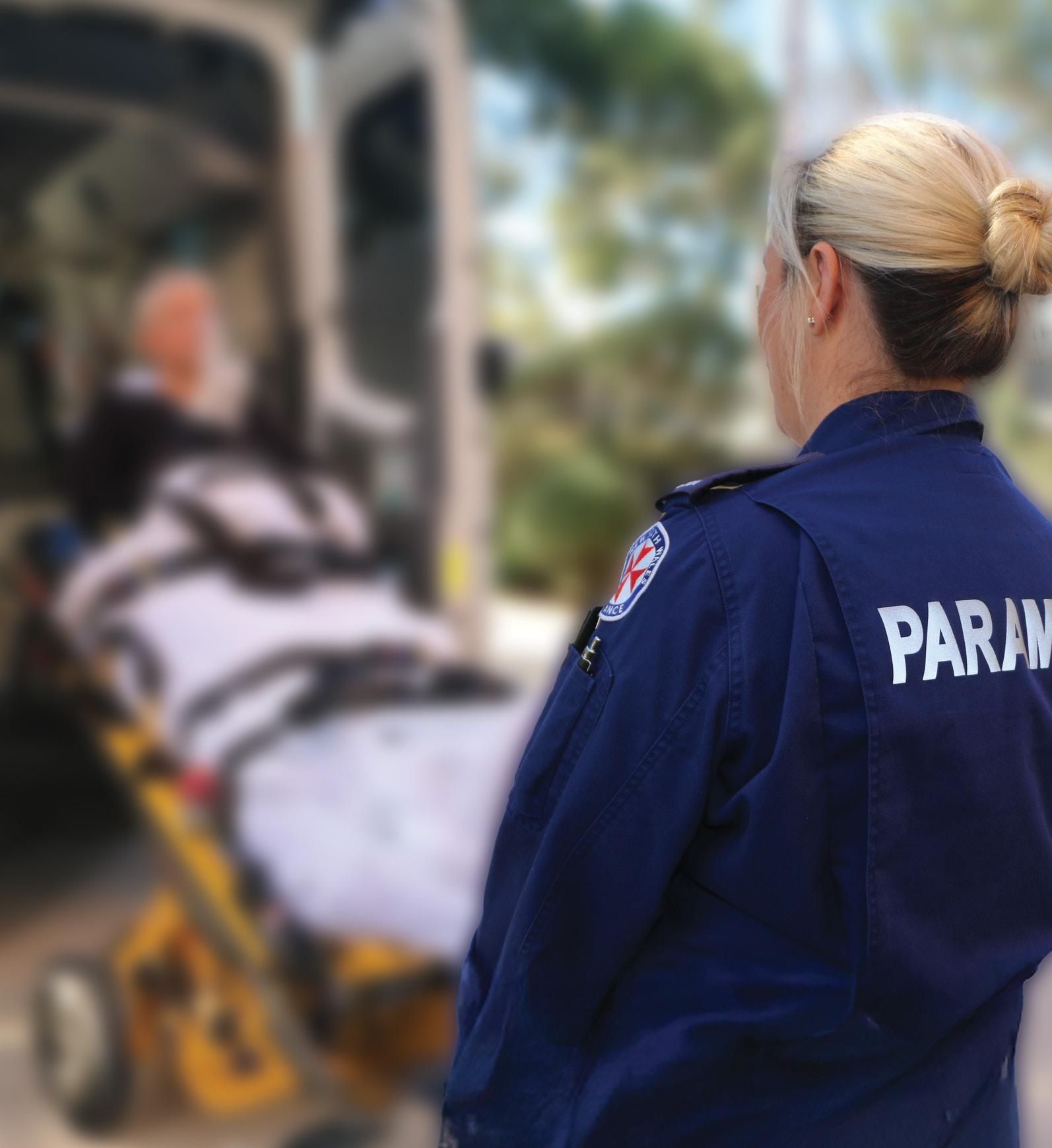



PARAMEDICS BEING SENT TO WEALTHIER SUBURBS TO PLUG GAPS.



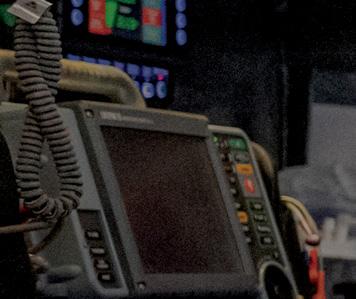
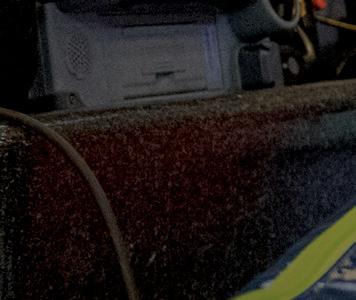

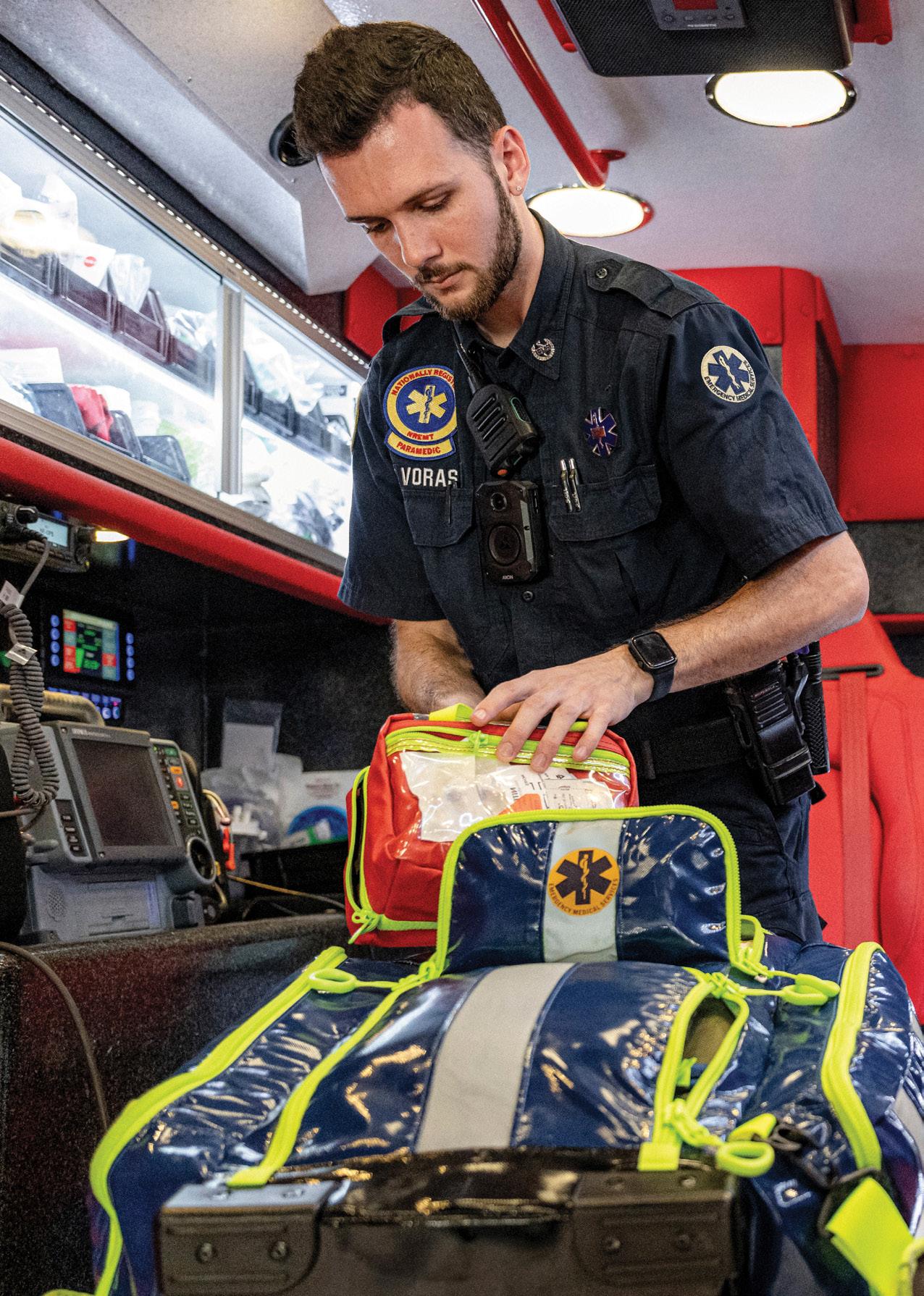























Treated correctly, your ESSS Defined Benefit Fund can be a big factor in helping you enjoy a comfortable retirement. So it’s important to weigh up the benefits right now and consider increasing your contribution rate.
With a defined benefit fund, you’re guaranteed a lump sum at retirement. It’s based on your average final salary multiplied by your ‘benefit multiple’. The great news is you have the power to increase your benefit multiple. One of the best ways to do that is to simply increase your contributions.
The sooner you start increasing your contribution rate, the more you can increase your retirement savings. For example, going from 0% to 7% could increase your benefit at retirement by as much as $495,000*. That’s a hefty sum.
You don’t want to miss out on that, so check your current contribution rate right now and see if you can afford a little bit more. Start feeding your super a bit extra today, and live life to the full in retirement.
To check or increase your contribution rate, call or visit:
*Figures based on 30 years of full-time service and a final average salary of $100,000. Emergency Services Superannuation Board ABN 28 161 296 741(ESSB) is responsible for administration of the Emergency Services Superannuation Scheme ABN 85 894 637 037 (ESSSuper).
There are complexities, for example you are restricted to changing your contribution rate percentage once per calendar year and grandfathering arrangements apply to ESSS DB Fund members who joined the ESSS DB Fund before 12 May 2009. If you reach your maximum benefit multiple, your contributions will cease. Members who have reached the maximum multiple will be eligible to receive additional contributions from their employer to be paid into the ESSSuper Accumulation Plan. Please refer to the PDS or contact us for more information.
The information contained in this document is of a general nature only. It should not be considered as a substitute for reading the relevant ESSSuper’s Product Disclosure Statement (PDS) that contains detailed information about ESSSuper products, services and features. Before making a decision about an ESSSuper product, you should consider the appropriateness of the product to your personal objectives, financial situation and needs. It may also be benefi cial to seek professional advice from a licensed financial planner or adviser. An ESSSuper PDS is available at esssuper.com.au or by calling 1300 650 161.
Australasian Council
PRESIDENT
Tess Oxley (HSU NSW)
VICE PRESIDENT
Faye McCann (First Union NZ)
Alistair Vagg (UWU Qld)
SECRETARY
Josh Karpowicz (AEA SA)
ASSISTANT SECRETARY
Simone Haigh (HACSU TAS)
June Congdon (UWU WA)
TREASURER
Olga Bartesek (VAU VIC)
ASSISTANT TREASURER
Darren Neville (TWU)
AMBULANCE
Craig Berger ( CWA ) 0426 954 744





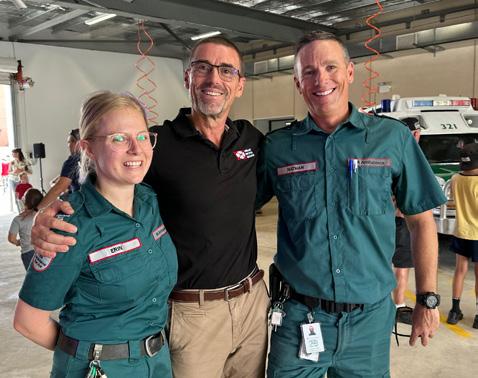

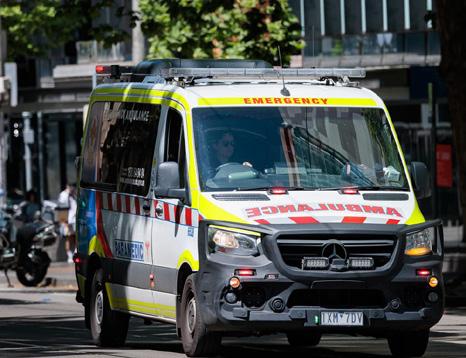

Challenges in emergency response are part of the everyday life of rescuers. Long distances and long transport times are problematic, as the oxygen supply is limited in most cases. With MEDUVENT Standard from WEINMANN Emergency you have a ventilator that works independently of oxygen. Thanks to turbine technology, it can ventilate patients without an external gas supply. With the low-flow supply you can easily supply patients with medical oxygen or concentrator oxygen.
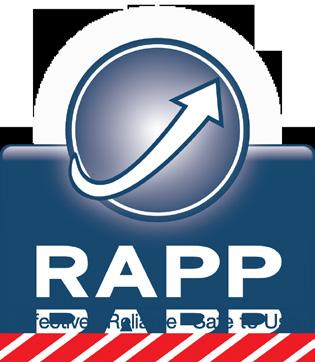


IN TODAY’S FAST-MOVING WORLD, social media has become one of the most powerful tools for communication. For unions, it's no different. Platforms like Facebook, X (formerly Twitter), Instagram, and WhatsApp have become essential channels for reaching our members quickly, clearly, and directly. Whether it’s sharing updates on bargaining, mobilising for rallies, or spreading the word about important campaigns, social media allows us to cut through the noise and speak with our collective voice.
We’ve seen time and again how a single post can galvanise support, expose unfair practices, or build solidarity across worksites. Especially when traditional communication routes are blocked or limited, social media becomes our frontline.

It’s democratic, it’s immediate, and –most importantly – it’s ours.
But with this power comes a growing threat: employer social media policies that aim to control what workers can and cannot say online. Some employers have introduced broad, vague policies that overreach –attempting to stop workers from fairly criticising the employer, discussing working conditions, or even expressing union support. This is deeply concerning.
Let’s be clear: while employers may have legitimate interests in preventing genuine misconduct or harassment online, these must never come at the cost of stifling union activity or silencing workers' voices. The right to organise, to speak out, and to communicate with fellow workers is protected in law and must extend into the digital space.
We cannot allow employer social media policies to become a backdoor to union suppression. That’s why we’re pushing back –in our workplaces, in policy forums, and where necessary, through legal action. Our message is simple: union communications, including those on social media, are not just helpful –they are essential.
As members, we all have a role to play. Stay connected, stay informed, and don’t be afraid to speak up online – respectfully and strategically. If your employer tries to limit your rights, talk to your delegate or organiser. As unionists we must stand together! Social media is a modern union bulletin board. We won’t let it be silenced.
In solidarity
“As members, we all have a role to play. Stay connected, stay informed, and don’t be afraid to speak up online – respectfully and strategically.”
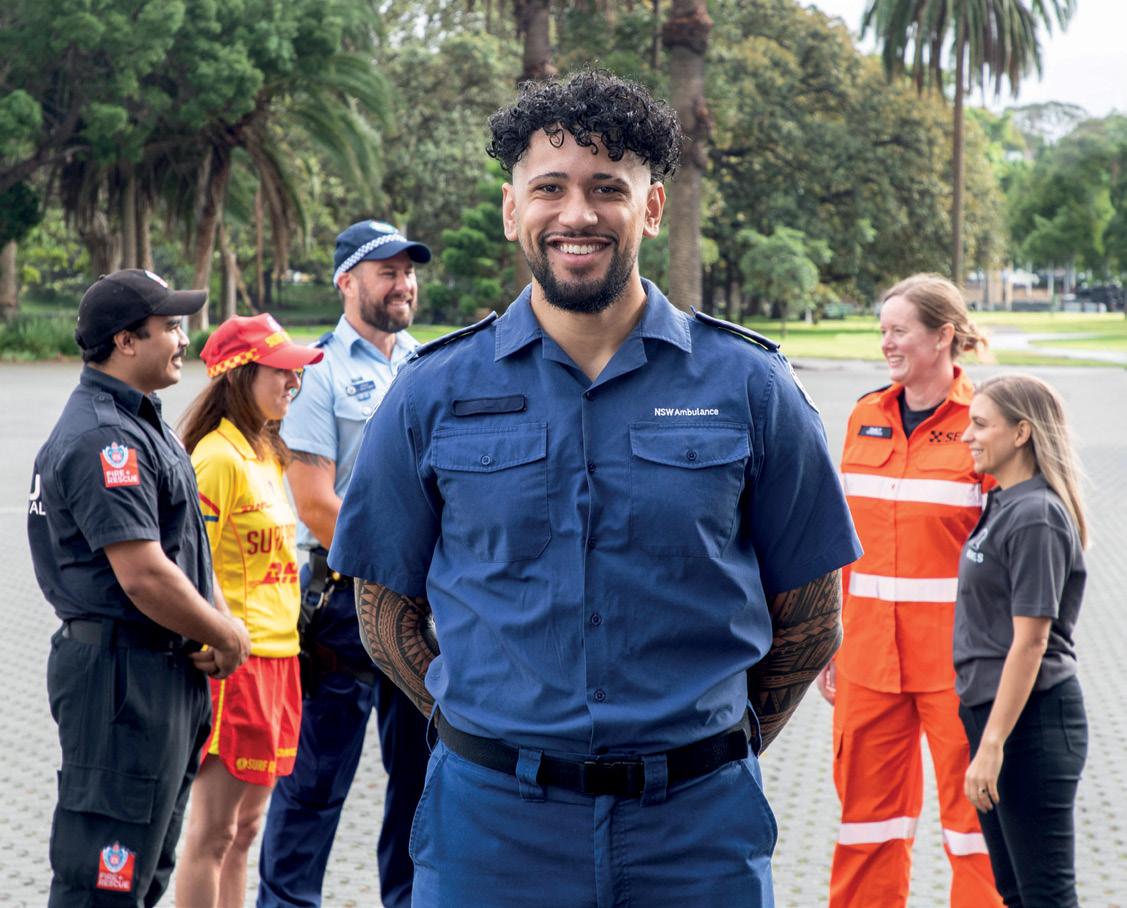
Australia’s emergency service workers and volunteers keep our communities safe, but stress and anxiety are often part of the job. Experiencing mental health challenges after a traumatic event is normal and very common — and it’s treatable, too.
Confidential support is available now:
• Take a quick online mental health check and receive a report that identifies your symptoms and provides recommendations for support.
• Book up to 12 sessions with leading, trauma-informed clinicians via telehealth or face-to-face. Free of charge, with no Medicare or GP referral required.
• Access information and resources to help manage your symptoms.
Visit our website nationalemergencyworkersupport.org.au

AS I STEP INTO MY FIRST YEAR AS Secretary, I look forward to the challenges and opportunities 2025 will bring. Our profession continues to evolve, and as unions, we remain steadfast in protecting and advancing the conditions of our members across Australia and New Zealand-Aotearoa.
I write this report reflecting on the important work ACAU has done in advocating for the mental health and wellbeing of our profession and the need for this to remain forefront in our actions. Sadly, too many of our colleagues continue to face challenges in accessing help and support. I want this to remain a national focus as Governments across Australia have still not implemented all of the recommendations from the 2019 Senate Inquiry into the mental health and wellbeing of first responders.
The ACAU Executive held its first meeting of the year in February, bringing together representatives from every State, Territory, and New Zealand to discuss the pressing issues facing our profession. Workforce shortages, member wellbeing, end-of-shift management, and health and safety remain key priorities.
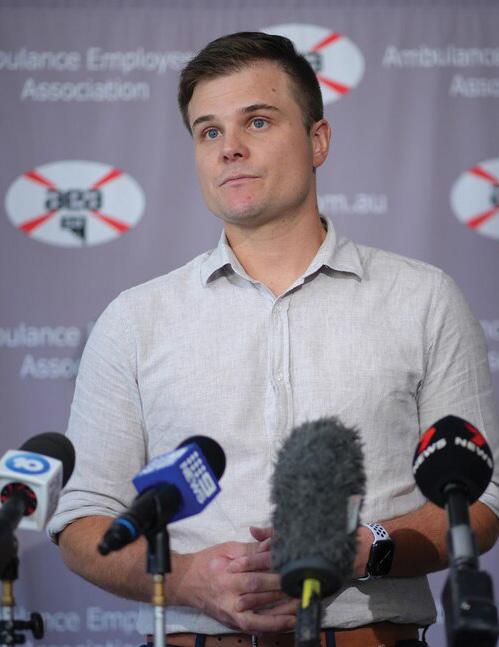
Workplace Health and Safety is a fundamental concern, and unions continue to play a vital role in advocating for safer working conditions, expanding Health and Safety Representative networks, and ensuring our members' voices are heard. Many of the challenges facing paramedics—fatigue, occupational violence, and escalating workloads— are rooted in WHS issues, highlighting the need for a combined approach of industrial advocacy and strong safety measures.
Enterprise bargaining remains a critical focus in 2025, with several unions negotiating renewed agreements.
The Victorian Ambulance Union’s recent success in securing strong pay and conditions is a testament to the power of collective action, achieved through sustained industrial action and unwavering member unity. Similarly, in New Zealand, FIRST Union’s ongoing campaign and strike action for fair wages and better conditions demonstrates the strength of sustained advocacy in achieving meaningful change.
Protecting and improving workplace conditions is more important than ever, particularly as our members continue to face high demand, frequent overtime, ramping, and workforce shortages.
In an environment where paramedics have little control over their working conditions,
we must continue work together to better secure conditions that protect our member from fatigue and high work pressures.
Another significant development in our profession has been the push for Paramedic Practitioner type roles. Thanks to sustained advocacy by many of our unions across the nation, Australian Health Ministers agreed last year to work with the Paramedicine Board of Australia to establish Areas of Practice Endorsements and secure independent prescribing rights for ‘Advanced Practice Paramedics’. This recognition of Paramedics’ expertise will enhance healthcare delivery beyond traditional ambulance services. However, further work is needed to ensure these advancements benefit Paramedics and the communities they serve.
Looking ahead, I am excited for the ACAU Strategic Planning Day slated to be held in Adelaide this May. This will be a valuable opportunity to refine our strategic direction, build on ACAU’s achievements, and strengthen our role as a national and transTasman voice for ambulance professionals.
Our collective strength lies in unity, collaboration, and shared learnings. By standing together, we are able to drive meaningful change for all our members across Australasia.
Take care of yourselves out there and I look forward to working with you all throughout this year and beyond.
Josh Karpowicz, a Registered Paramedic with 16 years’ experience, began his career with SA Ambulance Service in 2009. Now an Industrial Officer and Executive Member with AEA SA, Josh has also acted as Secretary, representing members in enterprise bargaining, employment tribunal matters, public campaigns, and policy negotiations. He combines his ongoing frontline paramedic work with strong union advocacy, advanced leadership training, and a drive to improving member conditions across the ambulance industry.
AFAC25 powered by INTERSCHUTZ Conference & Exhibition returns to Western Australia, delivering products, services, and solutions for all emergency management and first responder sectors.
Ambulance Fleet requirements, asset management, dispatch systems and fit out, PPE, equipment, workforce learning and development, community risk reduction strategies and systems, emerging response operations communication technology, and so much more. A world class showcase of international and national brands with best practice solutions for all first responder sectors.
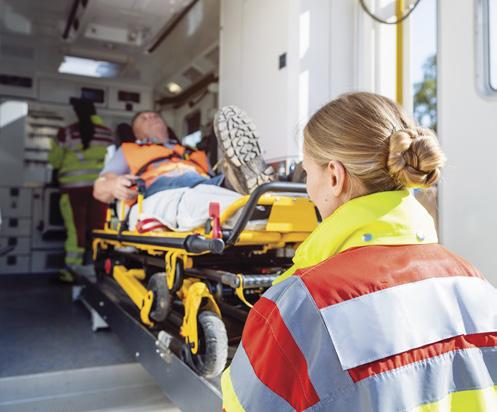




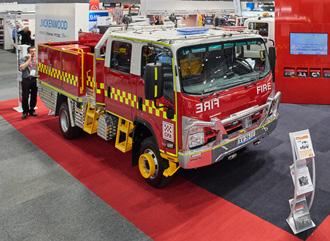


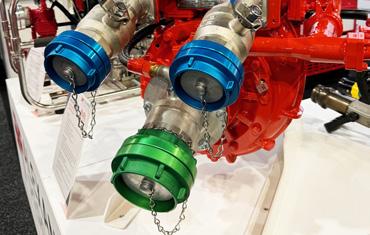

Delivering solutions to these industry groups:



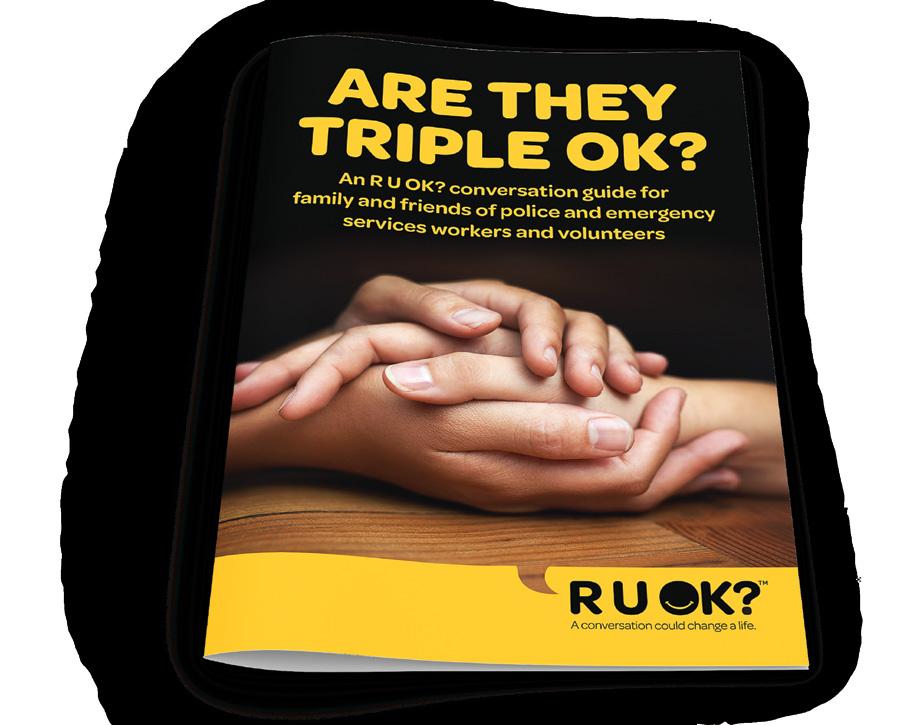


The R U OK? Are They Triple OK? podcast shares insights from emergency service personnel, from the love of the job to the challenges it can bring. We hear the voices of those with lived experience and share practical tools and tips on increasing social support for emergency services personnel, building a mentally healthy workplace, and how to have regular meaningful conversations with a peer or loved one who might be doing it tough. Scan to find out more



ACT MEMBERS ARE BACK AT THE bargaining table again with Agreement negotiations including a more equitable result for members not undertaking the 44 hour roster.
Members have been successful in setting out a new career pathway for non emergency with additional leadership capabilities.
Members in the Operation Centre have been engaged in a review to provide a more consistent and balanced set of operating processes across the service. There have also been preliminary discussion about improvement to infrastructure and recourses.
A new City Station is set to open in early 2025 with the first agreed design principles providing better areas for professional development and training. All we need now is are ambos to fill it!

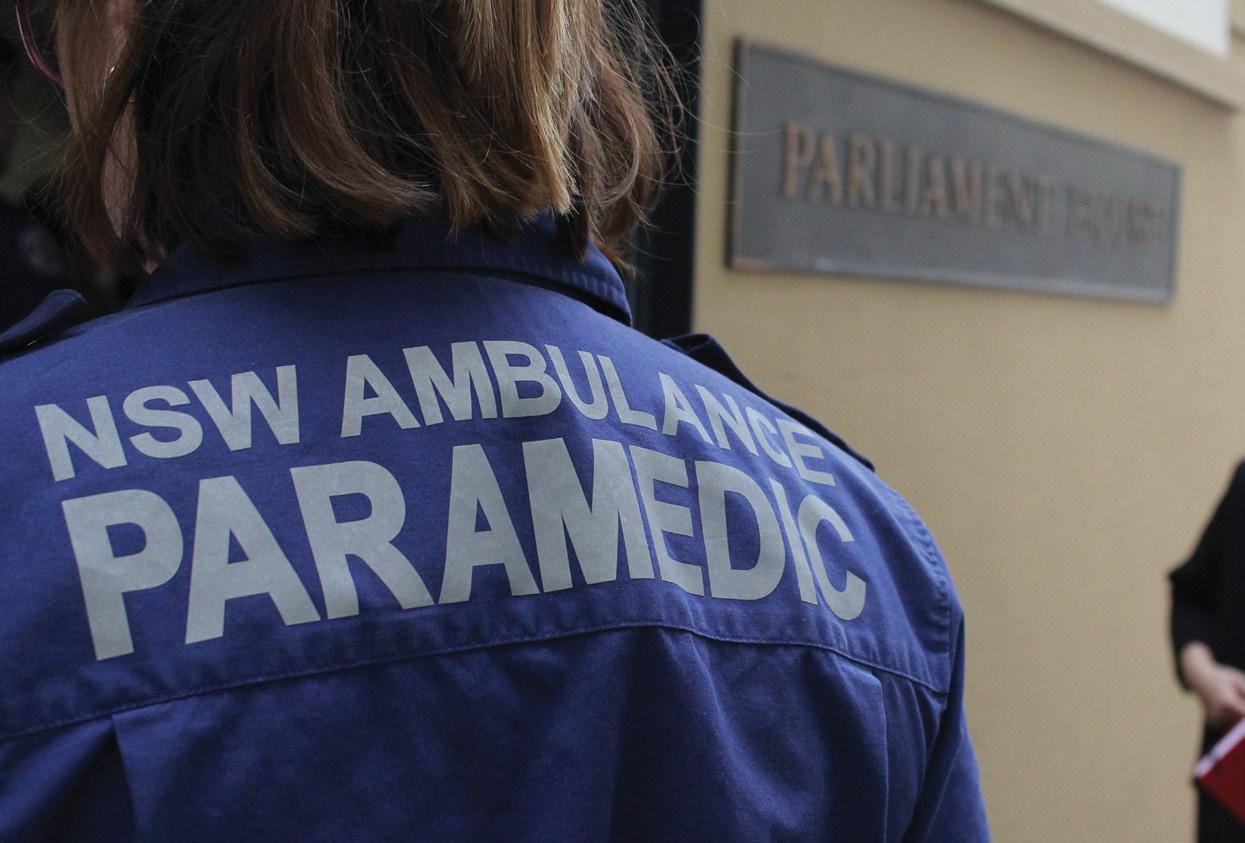
The start of the year has seen ADHSU Paramedics step up their campaign for Taxpayer Funded Rosters. Delegates and members have been meeting with their local State MP to discuss the importance of maintaining funded rosters to their Communities.
With Health response data showing worsening Ambulance Response times across the state, it is more important than ever that Ambulance rosters be maintained and utilised, rather than left empty as a cost cutting measure. The people of NSW deserve the Ambulance resources that their taxes pay for!
While the health and safety of their constituents should be every MP’s top priority, misinformation from the Ambulance service and a lack of awareness have left many hesitant to act. That’s why the work that ADHSU members are doing to dispel myths about union exaggeration or on-duty relief as a solution to unmaintained rosters is absolutely essential. The support is growing! MPs are standing with us—through photos, questioning relevant politicians, and speeches in parliament.
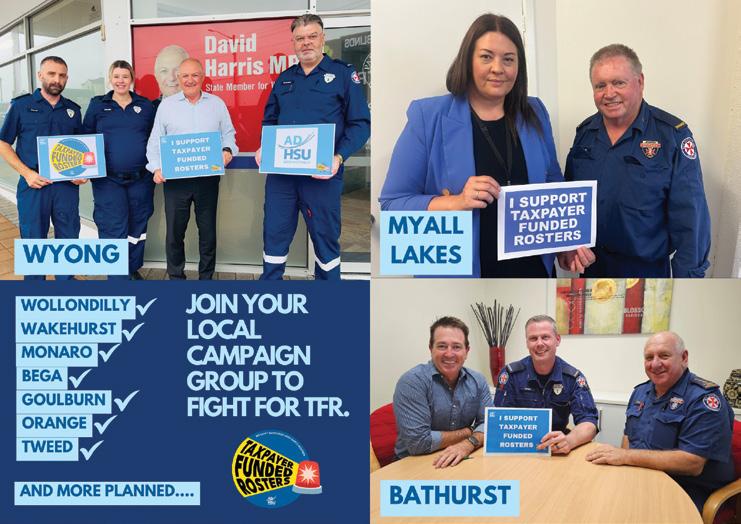
For International Women’s Day, NSW Ambulance’s Chief Executive shared a message about the organisation’s commitment to gender equality. He celebrated achievements, highlighted awards, and promoted a new Women in Ambulance symposium.
But behind these words lies a stark contradiction.
Right now, NSW Ambulance continues to deliberately underpay parttime women, placing them in the wrong pay bracket and failing to correct it. These women—many of whom juggle caregiving responsibilities alongside their essential roles—deserve fair pay, not empty rhetoric. All members should have received appropriate pay in line with the new Award payscale (effective Jan 1, 2024) but were forced to wait several months
due to understaffing. When the new payscale was finally implemented, staff who had worked reduced hours were inappropriately classified. After having to successfully fight for what was rightfully theirs in September 2024, members who were on reduced hours are still being underpaid.
If NSW Ambulance truly believes in accelerating action for gender equality, the first step is paying women what they are owed. Awards and events don’t put food on the table—fair wages do. We call on NSW Ambulance to fix this injustice immediately. It’s time for action, not just words.
The ADHSU Women’s Committee continues to take action to hold The Service accountable not just in the way they promote women in ambulance, but in the way they treat them!


ADHSU paramedics who commenced their career with other ambulance services have fought since the introduction of the new award to be paid at the year level they have earned while working in equivalent roles of other states/ services. NSW Ambulance have thus far refused to pay them higher than a year 2 ranking, while admitting that they do have greater experience. This is another purely budget cost cutting project by the NSWA executive. Members are encouraged to use their previous experience in progressing clinically, however must accept being paid at a much lower rate.
Members have taken their case to the Industrial Relations Commission where they have demonstrated their skills and experience. Members have made such an impact that the Commissioner ordered NSW Ambulance to seek an appropriate resolution. Congratulations to all members who have stood strong in this campaign.



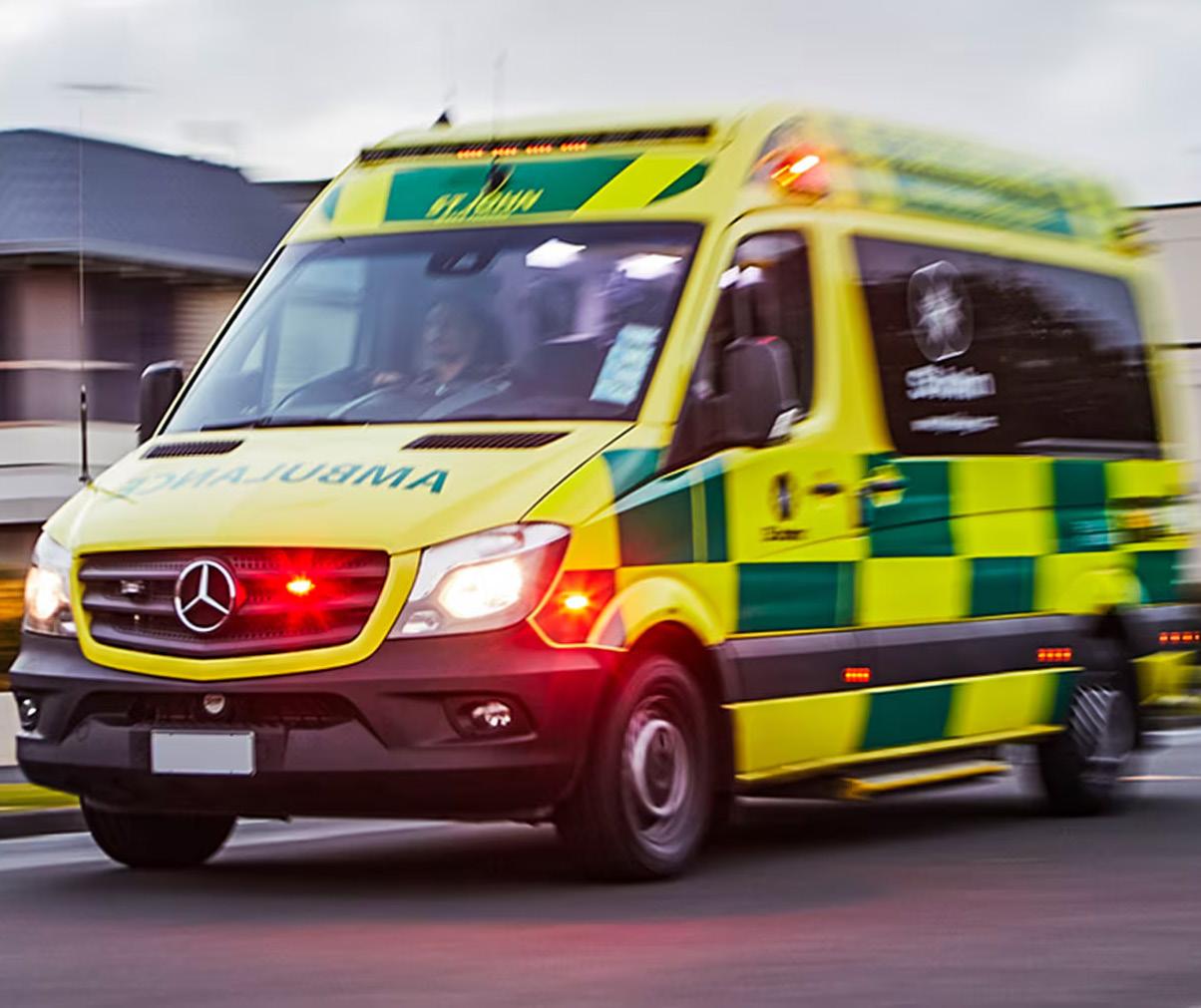
As a result of the last bargaining round with St John, an agreement was made to look into comparative remuneration of other health professionals in New Zealand and our colleagues across the ditch as we know our ambulance staff are underpaid for the roles that they do. We have had issues with the speed of this report knowing that it is crucial to have this information before St John enters in to the next contract with the government where funding will be confirmed for the next four years. Both ambulance services in New Zealand are partially government funded and still rely on donations from the public. Most ambulances that you see in New Zealand have been donated by members of the public rather than funded by the government.
Wellington Free Ambulance has agreed in the recent round of negotiations to add service steps to their remuneration so staff are recognised for the additional skills, knowledge and dedication to the service. Previously they were only paid an entry level step and would receive their next pay increase after four years of their ATP.
We are due to initiate collective bargaining for both St John and Wellington Free Ambulance on the 2nd of May. We are hoping to see an increase in wages that recognise members as the professionals they are and will be in a unique position to have strike actions occurring at the same time if members expectations are not met. New Zealand has not had both ambulance services striking at the same time before.
There has been an increase in assaults on crews this year and St John has put out communication to the public that this will not be tolerated, and they will be enabling their staff to walk away from unsafe scenes.
First Union has started an online petition for the government to fully fund the ambulance service now. An emergency service should not be run as a charity, the New Zealand public deserves an ambulance service they can rely on, not a service that relies on donations. You can support the petition by signing online at www.together.org.nz/ full_ambulance_funding_now
• Support for Nth Qld Flood affected members
• End of Shift trials
• Pay roll issues
From late January 2025 through to mid-February the Ingham community, in particular, has suffered from significant rainfall resulting in catastrophic flooding of homes and businesses. QAS staff and volunteers have been impacted along with the communities they support.
United Workers Union has a fund where members can access modest financial assistance in cases where extreme weather events have impacted. Climate Disaster Relief Fund – United Workers Union. Given the kind of rebuilding members in recent flood effected areas are facing, UWU State Councillors and Delegates from the Northern Region have set up a dedicated donation page via QAS Legacy, where you can contribute to support for those impacted staff.
Thoughts from all of us at the UWU office are with those impacted members along with great thanks to those members who have deployed from other parts of the state to support the work in the area as necessary.
The Gold Coast Region Hospital Based Crew (HBC) trial to address ever increasing shift extensions has demonstrated success in reducing shift extensions when in place. Based on this success an expanded and rebranded (End of Shift Crew) model is being further trialled in the Gold Coast Region. Metro South Region has also recently called for EOI’s around a similar trial.
United Workers Union delegates are pleased to see this Employee Wellbeing and Finish on Time initiative being supported. Delegates from across Southeast Queensland have been advocating at every opportunity to see some innovation in this space. UWU delegates willingness to speak up and engage with QAS leadership at regional and state levels has delivered these opportunities.
Addressing the End of Shift period and members ability to Finish on Time, more often than not, is likely to be a
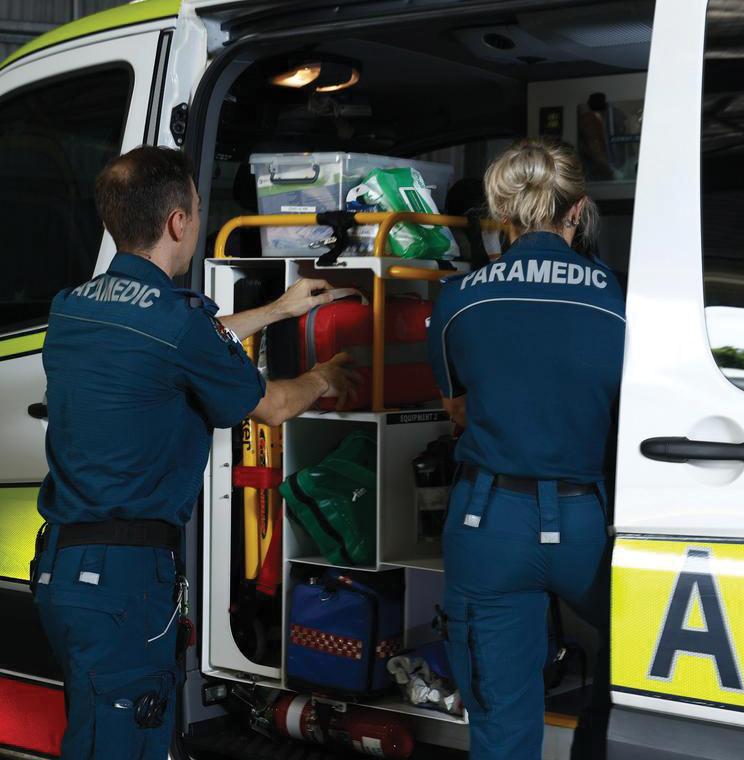
key focus of the upcoming Enterprise Bargaining negotiations. If the parties can have discussions and negotiate outcomes based on actual data from these trials, we hope to be able to deliver some real impact in this space.
United Workers Member Rights Team and Ambulance team organisers are supporting members with an unprecedented number of payroll issues. Not only are regular pay point progression’s being delayed by months and months, the processing of individuals fortnightly pay is consistently flawed, with errors taking place over multiple pay periods requiring significant expertise and time to resolve.
QAS cite QSS processing errors or delays, QSS cite QAS delays in submitting information or errors from the QAS HR end, and in the meantime, members go without
hundreds of dollars of pay on a regular basis which is no small inconvenience in the current cost of living crisis.
Once again, this issue will be discussed at the next State Consultative Committee and outreach will continue to be made on behalf of UWU members to both hold QAS and QSS accountable as well as to work towards a more sustainable way forward to resolve this systemic issue now facing members. Many members have attempted to have their payroll issues resolved and those who have reached out to UWU representatives are having their matters worked through to resolution. Recent announcements from QAS are promising in terms of dealing with some of the systemic issues. UWU members know this will take more than just acknowledgement and are willing and will continue to work with QAS on a better way forward.
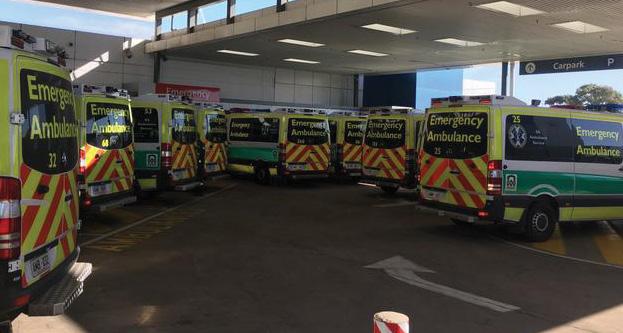
By Russell McQuade, Industrial Officer
Since our last Industrial Report, ramping hours remain below the peak of over 5,500 hours seen in July 2024, but have unfortunately increased steadily by 875 hours, reaching 3,981 hours as of February 2025. Despite this worrying uptick, there has been a notable improvement in ambulance response times for critical Priority 1 (e.g., cardiac arrest) and Priority 2 (e.g., chest pain) calls, as crews spend more time responding in the community rather than stuck on hospital ramps thanks to additional crews coming online from the 2022 State Election. However the last of the additional Metropolitan Crews are set to come online in July this year, worrying what the future holds if ramping remains unabated.
However, these gains in patient response times are likely negatively impacting member wellbeing. While our previous report celebrated significant wins in worker safety—including the updated Crib Break Procedure mandating crew breaks no later than 7 hours into their shift and the End of Shift Relief Procedure prioritising relief for crews finishing their shifts—members are increasingly reporting late crib breaks and post-shift overtime. The AEA remains vigilant in monitoring these issues closely to protect our members' health and safety and are advocating to SAAS for further refinements to cater for the impacts ramping has on releasing crews, not only to community cases, but to ensure their welfare.

In our last report, we highlighted ongoing advocacy efforts around telepsychiatry to reduce unnecessary transfers of psychiatric patients from peri-urban and regional communities. Earlier this year we consulted with the Chief Psychiatrist to advocate for the for broader use of telepsychiatry—not just for agitated patients under Inpatient Treatment Orders (ITOs) but also for those initially calm who may later become distressed during prolonged waits in ambulances at metropolitan hospitals.
Our stance remains clear: neither ambulance ramps nor emergency departments are appropriate environments for extended psychiatric care. Patients under ITOs should be transferred only when an appropriate treatment bed is available. We have also pushed for amendments to the Mental Health Act through the Chief Psychiatrist to support mandatory telehealth psychiatric reviews, potentially revoking or modifying ITOs prior to lengthy transfers, and to implement a reporting mechanism tracking the duration patients remain under care and control orders so that these patients do not languish on a ramp for hours on end.
The AEA continues to champion proactive, preventative mental health care for members, pushing SA Ambulance Service to engage with the Mind Your Head (MYH) program. This initiative, led by SA Unions in collaboration with ACTU, Return to Work SA, and the University of South Australia, uses cutting-edge research and practical tools to prevent psychological injuries before they occur.
Mental health injuries at work affected 21% of Australians in 2022, leading to substantial absenteeism and costing billions in compensation claims. Ambulance workers across the country face higher than average psychosocial hazards in their workplace. In the 20222023 Financial Year, our members made up over 35% of SA Health and Department of Health and Wellbeing workplace injury claims, despite Ambos making up less than 5% of the health workforce, and we are seeing increasing mental health injuries amongst members. With recent WHS legislative changes focusing heavily on psychosocial risks, programs like MYH are essential for maintaining and improving workplace mental health standards and compliance.

Fleet and Support Services, who remain proudly AEA members, are responsible for the servicing and maintenance of our statewide ambulance fleet. Our Fleet members have long raised concerns about workplace safety and management practices impacting daily operations. After sustained advocacy by the AEA and our members, SAAS commissioned an external review resulting in comprehensive recommendations, aligning closely with our longstanding suggestions, that SAAS could not ignore. A dedicated working group involving the AEA, member and rep representatives, and SAAS management has commenced implementation, already delivering tangible worksite improvements. Our commitment remains steadfast to ensure these recommendations result in safer working conditions for all Fleet members. This shows the strength in utilising both industrial and health and safety avenues to tackle member issues to ensure members working conditions are maintained and improved.
Members have raised concerns about the poor ventilation around the Ramp at Flinders Medical Centre (FMC) in the metropolitan south. In Adeliade ramped ambulances do not routinely off-load patients and contiune to care for patients whilst ramped inside the hospital. Instead, this occurs inside the back of the ambulance, and in the extremes of summer and winter diesel fumes for the required heating and air conditioning presents clear risks to members health and safety. The largely enclosed space at FMC is subject to poor air flow and with a large number of ambulances frequently ramped at FMC for protracted periods of time, members have reported significant health concerns with excessive diesel fumes. Other metropolitan hospitals with limited airflow have installed extraction fans to prevent the build-up of harmful fumes, however despite repeat reports from members of concerning symptoms, there had been little movement to provide the same at the cramped FMC ramp. FMC had previously sought two reports from Occupational Hygienists, of which the AEA had no visibility, and opted not to install fans to improve airflow. After strong AEA advocacy, using member reports of symptoms of exposure, SAAS sourced their own Occupational Hygienist, who produced a report supporting our members, which has resulted in FMC now installing two fixed exhaust fans aimed at significantly reducing diesel exposure risks.

Regional Inter-Facility Transfers (IFTs), particularly overnight, continue to exacerbate fatigue, reduce community coverage, and contribute to ramping.
The AEA’s relentless advocacy has resulted in critical changes to the Regional IFT Procedure, which restricts overnight regional IFTs between the hours of 2200-0700 hours, establishing clearer escalation pathways and allowing ambulance crews greater discretion in determining appropriate transport. However, despite changes in policy, challenges remained in changing culture, and regional members continued to face inappropriate overnight IFTs, causing undue fatigue. We reminded members of their right under WHS legislation to refuse unsafe work when concerns arise about cumulative or predictive fatigue and met with SAAS to ensure the updated procedure provided clear guidance on managing these risks, ensuring both patient safety and member welfare.
Since the AEA election in 2024, we have actively increased our numbers of Shop Stewards and encouraged our members to become local Health and Safety Representatives (HSRs). Previously underrepresented SAAS areas now benefit from improved local advocacy, ensuring health and safety concerns are promptly raised at both local and organisational levels, and not able to be ignored for significant periods of time. Our ongoing focus remains firmly fixed on protecting and enhancing member safety, ensuring members can deliver essential services without unnecessary risks to their own well-being.
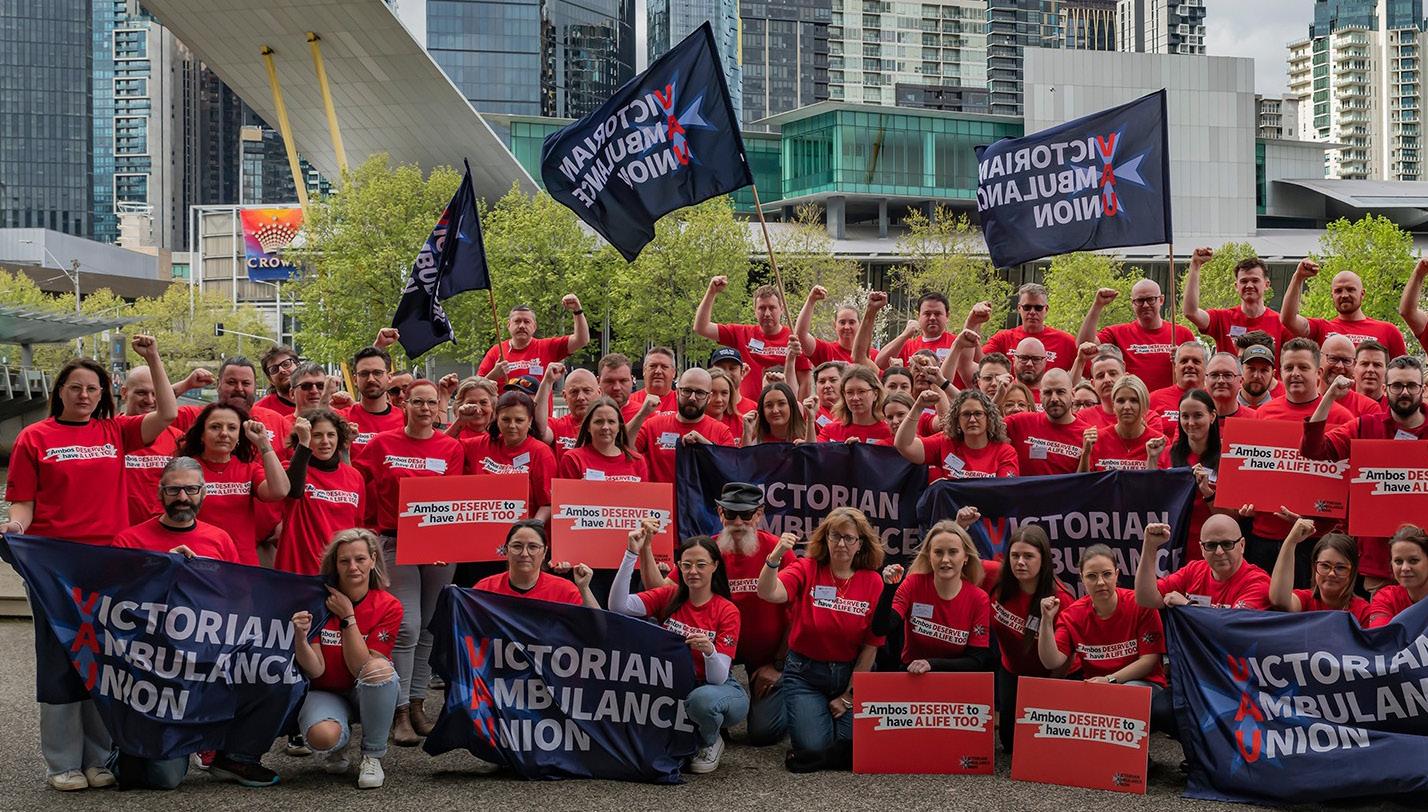
FOLLOWING A BIG YEAR (OR TWO) OF enterprise bargaining, members have locked in better wages and conditions with strong votes and have begun seeing some of the improvements flow through over the past 18 months.
A new enterprise agreement for calltakers, dispatchers and team leaders at Triple Zero Victoria was voted up by 88.2% of the workforce.
The TZV deal included:
• 3% annual wage and allowances increases for the life of the agreement
• $5,553 sign on payment for all permanent employees (pro-rata part-time)
• Improved career structure
• Increased weekend and night shift penalties
• Increased overtime rates on weekends.
• Increased mentor allowances.
• Increased public holiday penalties.
• Additional leave entitlements outlined in the Leave policy, including Purchased leave, Reproductive leave, Secondary Caregiver leave, Blood donation leave, Cultural and Ceremonial leave and Defence Force leave, and better access to planned leave.
• Career breaks and 80/20.
• Improved Staffing levels.
Members have already received their back pay of 3% and sign on bonus, however are still awaiting the career structure to come
into effect. The VAU is keeping pressure on TZV to complete the process as promised.
The VAU and CWU, recently took a dispute to the Magistrate Court regarding workplace trainers not receiving mentoring allowances. We were successful at the Magistrates Court however the decision has been appealed by TZV in the Federal Court. The VAU and CWU attended last week and are awaiting a decision.
The Ambulance Victoria deal was circulated to the members in late November 2024 to be voted on. Over 97.3% of the AV workforce voted to accept the agreement. The agreement came into effect on 21 February 2025 and members have begun receiving the first tranche of improved wages and conditions including:
• Wage increases ranging from 16.98% to over 33%.
• Base wage increases of 4% per year for all classifications.
• Years of service increments increased to year 12.
• Additional $12,500 MICA relativity uplift.
• New MICA salary maintenance entitlement.
• New $5 per hour Community Officer availability allowance.
• Increase to CI allowance.
• Increased unsociable shift allowances.
• Increased travel allowances
New End of shift management model –Phased in over 12 months.
• No Code 2’s or 3’s in last hour of shift.
• Members will be marked out of service at the end of every shift.
• Further improvements to ‘right to refuse’ unreasonable overtime.
• 84 additional communications staff to assist with workload, end of shift management and to allow screen breaks to occur.
• ALS clinicians to assist with case review for end of shift management/ meal breaks.
• New three-tiered rural shift allocation model to reduce reliance on forced spare requiring AV to properly recruit to and exhaust RSRPs and volunteers. $100 per day for flexible shifts, $65 per day for flexible cycle, or refuse and start and finish at your home branch. RSRP travel arrangements apply.
• Introduces the option of a flexible cycle allocation at one location
• Introduces the right to reasonably refuse.
• Metro increased payments from $49 to $65 per shift for flexible cycle and $100 for flexible shifts (day to day reserve)
• Increased access to ‘Single Days Off’, ability to lock in 12 months ahead, cash out option, AV will not unreasonably refuse requests.
• Introduction of Timebank into the EBA to allow entitlement to become enforceable.
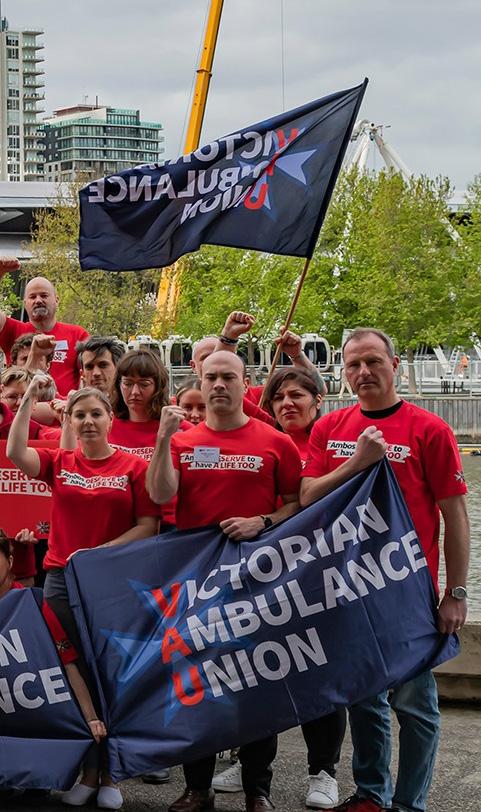
• Improvements to union representation clauses
• Improvements to performance management, disciplinary and procedural fairness clauses
• 30 mins meal breaks for all shifts 6 hours or more.
• New hour count clause with improved protections for claim overtime after roster changes.
• New OHS clause with major improvements to health and safety protections
• New workload clause
• New bullying and harassment clause with improved protections for members
• New meal break provision for on-call crews.
• New transition to retirement clause.
• New ACO meal break entitlement from 20 to 30 minutes to align with their paramedic partner.
• Improved Flexible Working Arrangement clause.
• Wage progression when in an acting in a higher level position and ability to have time in acting positions taken into account when appointed.
• Improved employee engagement through new consultation clause.
• Better protections for people in fixed term employment.
• Improvements to casual conversion clause.
• Improvements to family and domestic violence leave clause
• New Organ Donor/Bone Marrow leave, Assisted Reproductive Leave, and gender affirmation leave.
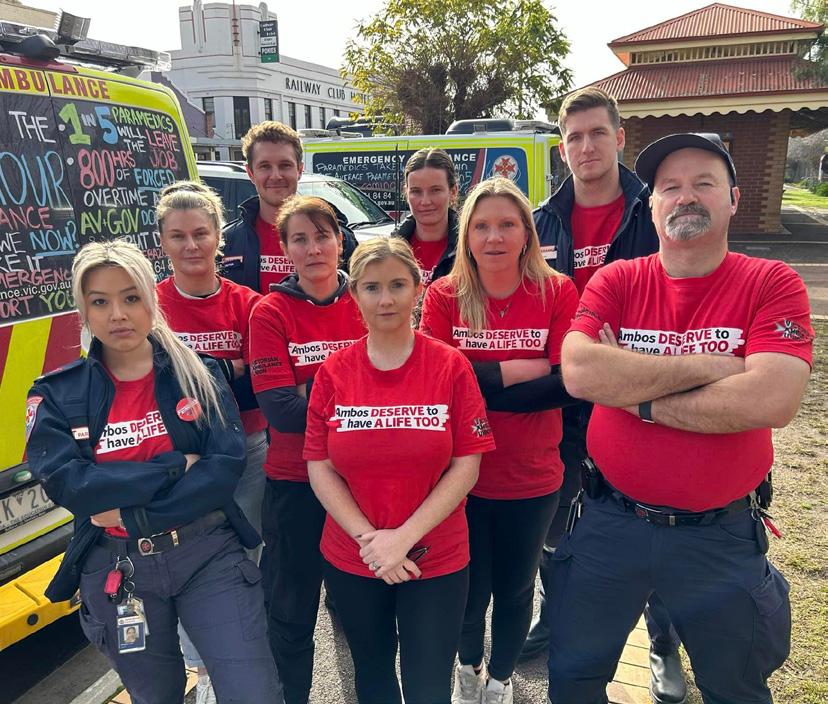
• 10 Keeping in touch days able to be undertaken as observer shifts at ordinary rate of pay
• New Gender equality clause
• New right to disconnect clause protecting against contact after hours unless in a position paid for that commitment.
• Improved Anti-discrimination clause
• Improved Long Service Leave clause
• Provide an all-weather jacket (Car Coat) to all operational employees (including casuals) as part of uniform.
• Damaged, lost or stolen headphones to be reimbursed up to $600
• New 6-month career break clause
• Screen intensive duties clause and additional staff to allow breaks for Triage Services, Flight Coordinators, DMs, CSPs and Clinicians.
The VAU has begun collecting claims for a new enterprise agreement with Health Select. Following discussion with members, key claims are likely to be related to recognition of years of service to bring Health Select in line with other NEPT companies who reward staff for their time in the job.
Since July 2024, the VAU and ANMF have had approximately twenty meetings with the Royal Flying Doctors Service (RFDS) for a new enterprise agreement.
The parties have had positive discussions on matters relating to:
• Wage increases
• Clinical observer and supervision allowances
• New disciplinary protections
• Shift allowances
• Paid union delegate leave
• Reimbursement of drivers licence and working with children check
• Protections for part time employees
• Years of service for PTOs and operations centre staff
• Increased on-call allowances
• Right to disconnect clause Matters still outstanding include meal break amenities and allowances, OHS clause, dispute resolution and sign on bonuses. We are hopeful that agreement will be reached soon so that an agreement can be put out to the vote.
The VAU is in the process of collating a log of claims for members covered by the AV management and administration agreement. A larger cohort of frontline staff including Communications Administration Support Officers, Retrieval Support Officers, Emergency Management Planning Coordinators and other positions have moved into this agreement and it is important that the benefits of the operational agreement flow across to these members.
By Tim Jacobson Senior Industrial Officer
In late 2024 we participated in a formal review of the Transfer of Care Procedure implemented across all of Tasmania’s major public hospitals in April 2024. The review will commence in September 2024. In general, but more specifically, our representations regarding the problems we see with the protocol as it currently stands were:
• At all three North and North-West Public Hospitals we had seen a marked improvement in Ramping since the procedure had been implemented
• We believed that cultural problems existed at the RHH that were impacting on the operation of the procedure.
• Our experience with the RHH is that the hospital proper (excepting the ED) did not have the Procedure at the front of their mind and that as a result, were not actively managing patient flow even on high caseload days.
• We believed that each hospital should have their own Policy (Separate from the Ambulance Transfer of Care Policy) that is actively managed and resourced at each hospital.
• That in times of high demand and increased incidents of ramping that hospital nursing staff be redeployed to the ED to relieve Paramedics and enable the ambulance resource to return to the community.
• That we believed that the hospitals had no understanding or appreciation of the work that sits behind ramping in AT. We believe that hospitals should be educated on what resources are tied up in Ambulance with patients are ramped.
We were advised (at the time of writing) that the final report of the reviewer has been provided to Ambulance Tasmania and we are hopeful that we will receive it over coming weeks.
HACSU has provided detailed responses to both of the following Change Proposals. AT has taken on board many suggestions made by us:
• Critical Response Unit – Selection Procedure Change Proposal
• Voluntary Employee Transfer procedure
On Wednesday 26 February the State Communications Centre was evacuated as a result of maggots (yes maggots) dropping through the ceiling in the Centre. Ultimately it was found that a gull had died on the roof of the centre and as a result of decomposition maggots had made their way into the ceiling cavity. It was only as a result of our threats to take industrial action and WHS action that management ultimately agreed to exit the centre and undergo a complete survey of the ceiling space and deep clean of the Centre. On the Thursday following the “all clear” from the occupational hygienist’s that staff moved back into the Centre.
As the result of industrial action initiated by Members in the State Communications Centre, we have been able to have AT focus on new recruitment processes into the Centre. Several new call takers are currently being trained and should be job ready by the end of March. As a result of the vacancies members have been regularly asked at short notice to change their rosters. Part of the industrial action was that members would refuse to do this unless AT paid overtime to them for any shift changes. AT have agreed to pay overtime until the end of March when we again review staffing in the Centre.
We have also achieved additional parking directly outside the Comms Centre as well which has largely addressed Members safety concerns.
Ambulance Tasmania has agreed to settle a dispute regarding salary and classification matters relating to the above groups. Whilst, at the time of writing we are yet to receive a formal offer, Ambulance Tasmania have verbally agreed to an outcome which includes a significant backpay component for each group.
The usual incompetence from this Government has resulted in a fancy new station being built that doesn’t even meet the current safety needs of the staff let alone future staff.
The station was only equipped with four rest and recline rooms when given the size of crewing at the station requires there to be six. Initially management agreed to create two additional spaces to settle our concerns but then simply turned two of the current spaces into shared rooms.
Having attended the Station I advised AT that there were two additional rooms at the station that could be converted into recline spaces and that unless they agreed Members would be willing to take Industrial Action.
AT have responded agreeing to convert two of the spaces into stand alone rest and recline rooms.

The March Union Executive meeting focused primarily on finalising the Draft EBA Claim for Member endorsement. The current agreement expires in June and along with most other public sector agreements, the next wages increase is due on the first full pay period on or after 1 December this year. Membership meetings will occur over coming weeks when Members input into the draft claim will be sought.
AT is dragging their feet on the development of a comprehensive Fleet management and Replacement Policy. We have raised serious concerns with Ambulance Tasmania on the lack of progress and as a result have cancelled a scheduled meeting in order for them to undertake more work on the Policy. We received a Policy that was bare bones and, in our opinion, insulting!
Currently AT has no fleet Management and Replacement Policy. We are seeking a comprehensive Policy that ensures that at all times, the Type 1 Ambulance Fleet is actively maintained and monitored.
AT is choosing to implement a policy which is bare bones at best.
This is a matter that is likely to result in either Industrial Action or WHS action if it remains unresolved.
We have recently reestablished direct communications mechanisms between HACSU NEPT Members and Ambulance Tasmania. Several Statewide and Regional Matters are currently under discussion with Ambulance Tasmania in this forum.
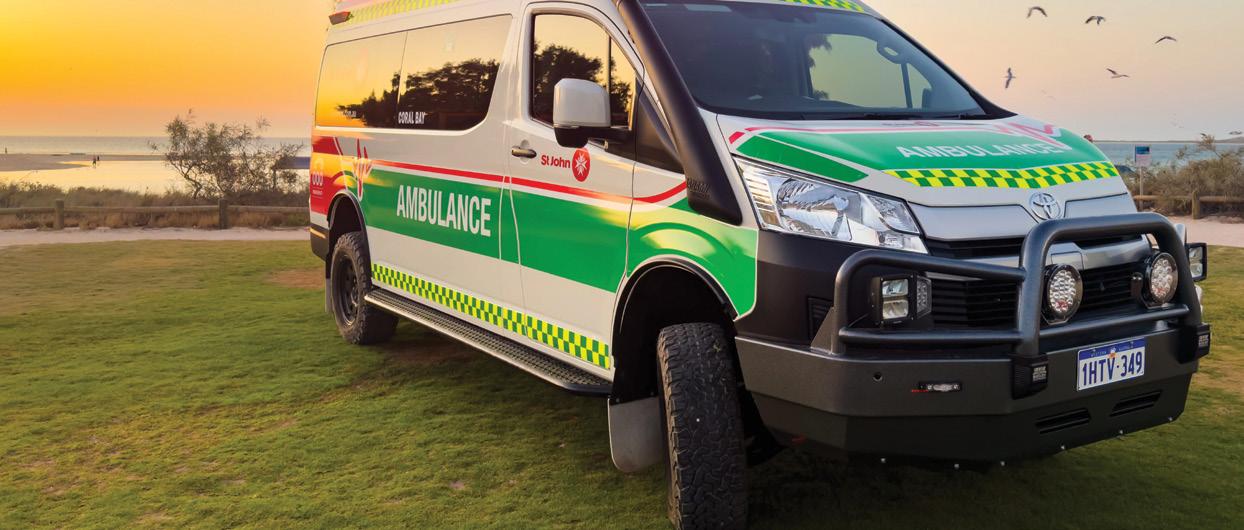

After months of negotiations St John Ambulance put an Agreement covering Paramedics out to vote in early March. Neither bargaining party gave In Principal Agreement to the document that ended up being put to a ballot and 89% of staff have voted NO! Key issues that remain outstanding are the pay offer and a change in shift length and type.
United Workers Union members have lodged with the FWC for a Protected Action Ballot Order and will be working with members on rolling out Actions if and when members determine this measure is required, and St John Ambulance have indicated they will be lodging with the FWC for a process that facilitates an outcome.
The First Aid trainers Certified Agreement remains in limbo with a number of issues being heard by the FWC after lengthy negotiations resulted in an improved offer members voted in favour of late last year. United Workers Union delegates on the negotiation committee are hopeful for a resolution in coming weeks.
Digital Transformation
– Project Lighthouse
St John intends to procure a number of modern digital solutions to replace the aging and inefficient systems currently in use. These include:
• An Enterprise Resource Planning (ERP) System which will assist with billing, fleet management, employee records, and leave usage.
• A Workforce Management tool which is intended to provide digitised rostering, digitised timesheets, and streamlined payroll.
• A new Information and Knowledge management system to keep better patient records and contribute to datadriven decision making.
• The goal for initial rollout is AugustOctober this year. Delegates are looking forward to the roll out of digitised rostering, overtime, leave and time cards.
More information about Project Lighthouse is being provided by St John. If you and your colleagues have any concerns or queries about the project, please get in touch.
Access to Long Service Leave continues to be a pain point UWU members. St John has admitted to poor leave management and has recognised members are being unfairly denied Long Service Leave.
St John advises they are working on the Long Service Leave issues and are running into problems with incorrect data and significant leave accruals. Meanwhile, UWU representatives continue to work with St John to advocate for members to access leave entitlements.
With Covid well and truly in the rear-view mirror, UWU Delegates firmly requested St John apply pressure on Sir Charles Gairdner hospital to return A-bays as per pre-covid arrangements. Inconsistent use of a-bays is a huge contributor to ramping. According to St John, the former CEO’s position on a-bays was multiple handovers creates patient risk. However, St John has committed to reconsider this position and look at options. UWU Delegates look forward to discussing alternative arrangements with St John.
January has seen the worst January ramping on record, with some crews being ramped their entire night shift. You and your colleagues are reporting P1s are being called to areas that are a significant distance away due to a lack of available crews.
Serious ramping issues in summer are a grim projection into the future, and your Delegates have firmly pointed out that this does not bode well for winter and we need a plan for ramping now.
St John points to the health system overall as the cause of the problem, however our position is that St John still has levers to pull with government. Additionally, the lack of transparency around the Ambulance Service Agreement means it is unclear what level of service St John has been contracted to provide. As paramedics providing services to the public, you and your colleagues deserve to know what is in the contract to be able to advocate and address ramping issues effectively.
Delegates raised two concerns about the procurement of new uniforms. The first is a minor batch issue where the ‘Paramedic’ on the back is peeling off. St John advises this should be resolved in the next batch.
The second issue raised relates to the material being made up of 80% polyester. During the recent Perth heatwave, members wearing the uniform experienced additional heat exposure in the new uniforms. St John has taken this on notice and has committed to address it in further conversations.
Members have been advised to lodge an incident report and use old uniforms where possible.
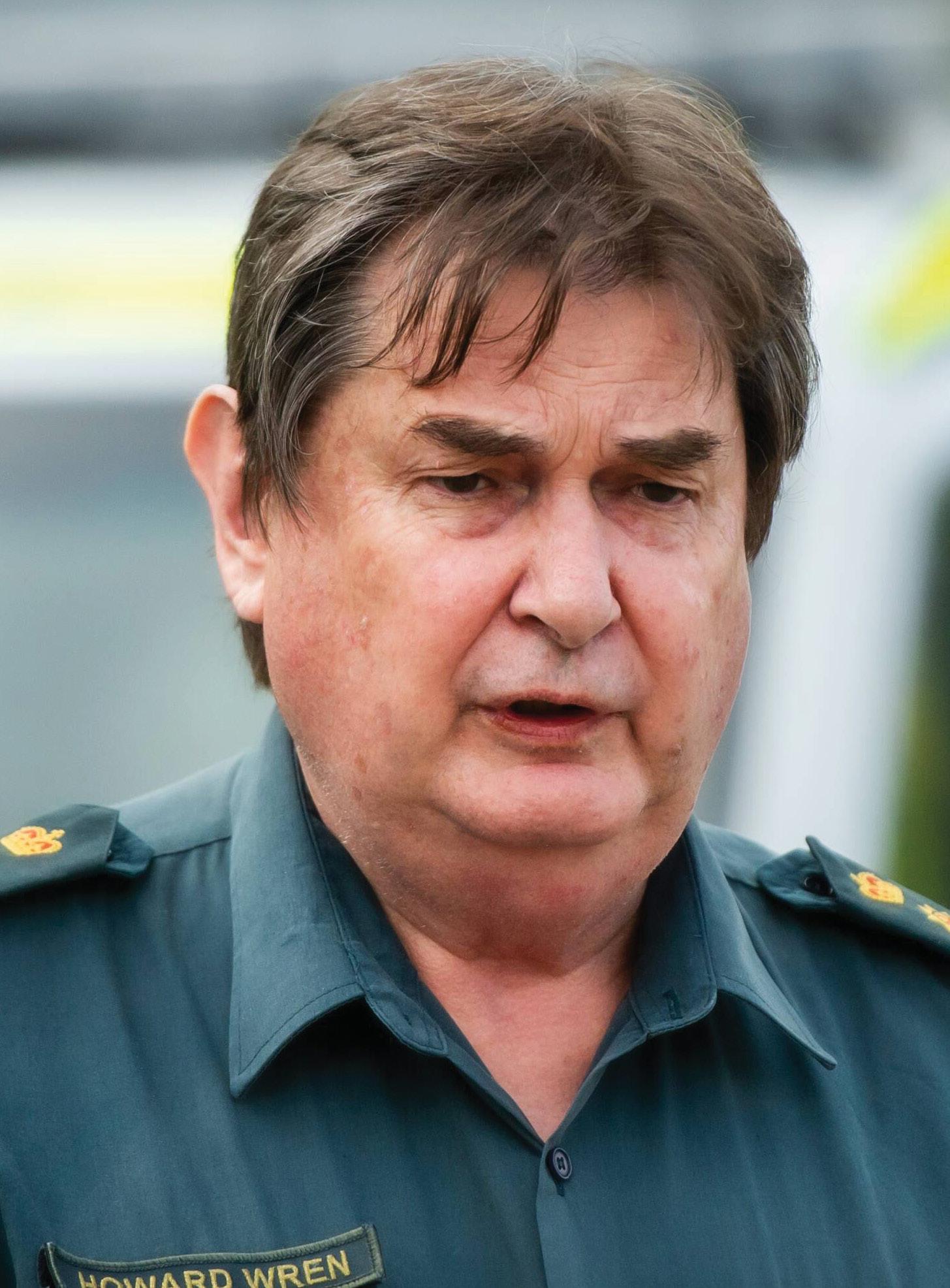
ACT Ambulance Chief Officer retires after five decades of service.


Chief Officer Howard Wren will be retiring from his role after over 50 years in the ambulance and healthcare fields.
Throughout his career, Mr Wren’s impact on NSW and ACT healthcare has been significant, leaving a legacy for many years to come. Some of the key initiatives that Chief Officer Wren has been part of include:
• Guaranteeing a defibrillator is available in every frontline ambulance
• Ensuring effective pain relief is accessible to patients
• The education and training of many paramedics
After five decades in the industry, Mr Wren reflects on how far the role of paramedics has come and assures that the ACT is in safe hands.
“When I started my career as a paramedic in 1974, all that was required
driver’s license and a few first aid certificates,” he said.
“Back then, never did I envision that the service would grow so much, with paramedics now being qualified health professionals.
“This is one of many changes I have witnessed across my five decades of service. Paramedics are now also more gender diverse than they have ever been and are equipped with life-saving tools that just weren’t available 50 years ago. I am proud to have been a part of each change no matter how big or small, helping improve healthcare, not just in the ACT, but across the nation.
“I’m retiring knowing the ACT community is in safe hands. ACTAS truly is one of the most forward-thinking and innovative ambulance services in the country, filled with exceptional people. It has been a privilege to have been a part of this organisation and to have served the Canberra community.”
Fire and Emergency Services, Dr Marisa Paterson, paid tribute to Mr Wren for his dedicated service to the Canberra community.
“Chief Officer Wren’s career progression is a remarkable representation of what it means to build from the ground up. His journey as a paramedic reflects an unwavering commitment to his peers and the community.
“The Canberra community is indebted to Chief Officer Wren in leading reform that has set our ambulance service up for years to come.”
Mr Wren’s last day in office was Friday 28 February with ACTAS General Manager, Clinical Governance Unit, Patrick Meere, as the interim ACTAS Chief Officer while a recruitment process is underway.
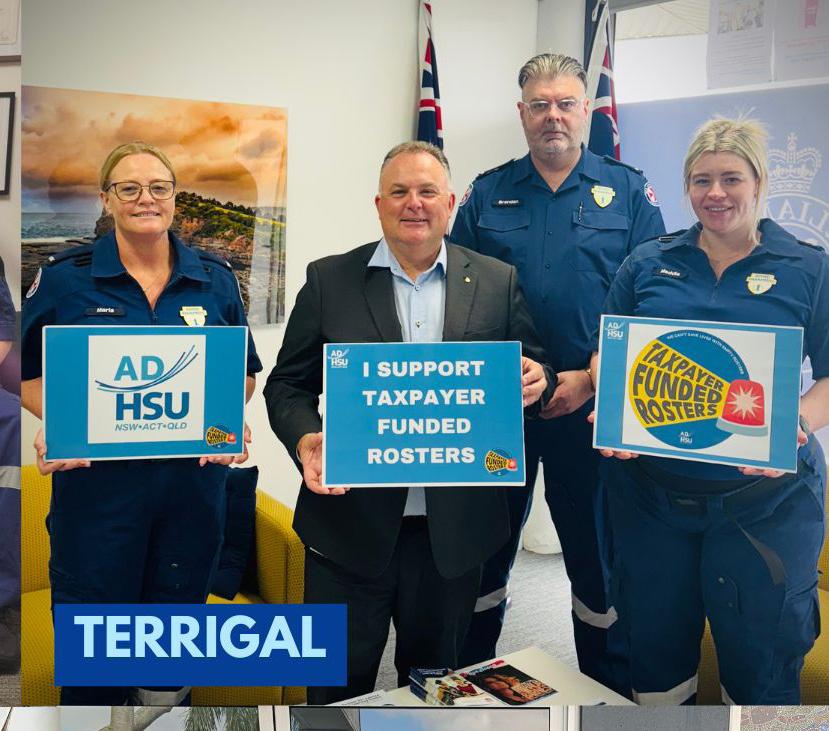
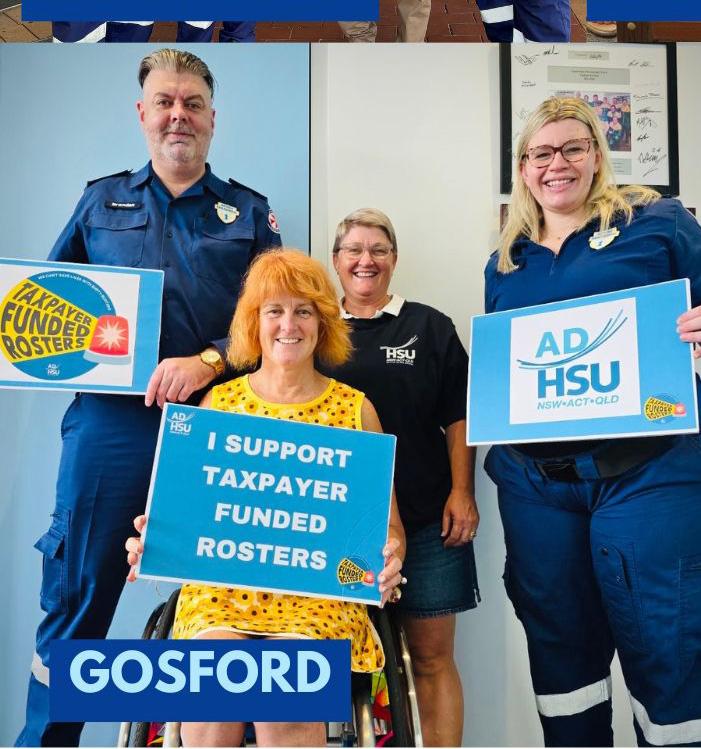
More Members of Parliament pledge to push for the maintenance of taxpayer funded rosters! This makes 25 meetings ADHSU members have had with their state MPs. It seems as though more and more of NSW parliament believe NSWA should be maintaining the rosters that taxpayers have already funded.
IN TAMWORTH, PARAMEDICS ARE awaiting an increase in staff which they are terrified will not be maintained. They are not going to put up with their extra staff being punted away to other areas to fill gaps like the rest of the state.
Campbelltown, along with the rest of South West Sydney, sufferers from some of the worst misallocations of resources in NSW. In this area, they can be missing 18 ambulances before NSWA attempts to replace one. Resources that have been allocated and funded for this area get sent elsewhere daily, mostly to higher SES suburbs.
Similarly, In Terrigal and Gosford, ambulances are constantly being sent out of area to Sydney and Newcastle. Despite this, NSWA still sees no need to maintain staff at Lisarow, Morriset, Kincumber and Hamlyn Terrace stations.



Riverstone and its surrounding areas have some of the highest response times in Sydney Metro. It is one of fastest growing areas in Sydney terms of population, with median response times approaching 20 minutes for lights and sirens cases which should be no longer than 10 minutes. Finally, Coffs Harbour paramedics deal with ridiculous staff movements daily. ADHSU data found that in 65% of instances of stations under TFR, overtime was not advertised. These members are sick of NSWA's consistent lack of effort to fill gaps or properly resource the Mid-North Coast. Every meeting counts. For assistance in planning your local meetings, fill out your name using the link below. Keep wearing your ADHSU shields and keep chalking your cars. Let’s win this together. https://bit.ly/ADHSUTFR
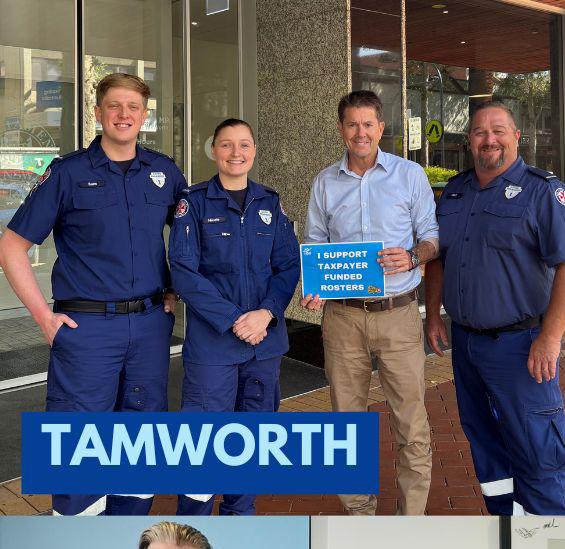

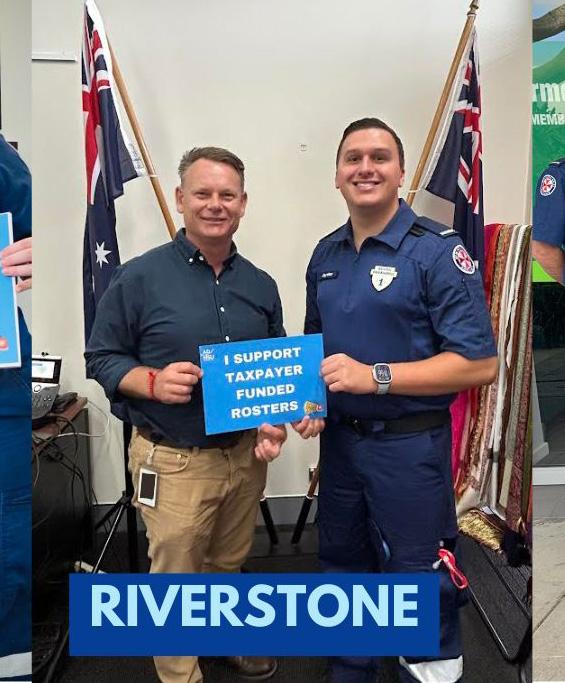
Western Sydney paramedics being sent to wealthier suburbs to plug gaps, leaving patients at risk.

WESTERN SYDNEY COMMUNITIES ARE being put at risk, with paramedic response times being delayed because they are plugging gaps in other suburbs.
The Health Services Union is warning communities are being short-changed in a dangerous way, because of rostering failures.
In some communities in the Greater Sydney area, wait times for an ambulance during a 'Priority 1' lights and sirens job is nearly 20 minutes. That can be a matter of life and death.
Members of the Health Services Union say staffing levels and crews being diverted to plug gaps elsewhere are major contributing factors to this lapse in response times.
“This is not about asking the state government for more money. The money is already there. NSW Ambulance was allocated $1.76 billion over four years to increase paramedic numbers and fill rosters, but that’s not happening,” Health Services Secretary Secretary Gerard Hayes said.
HSU members are urging the NSW Government and Ministry of Health to direct NSW Ambulance to use the funding appropriately by back-filling the rosters for paramedics.
Members and delegates are meeting with local MPs across the state to push for immediate action.
“The NSW Government must act now to protect patient safety and ensure that taxpayer money is used as intended; to provide fully staffed, sustainable paramedic services that meet the needs of the people of New South Wales.
“What we are seeing is that some crews are considered “extra” under the current model, and they aren’t replaced if they can’t make their shift. They weren’t intended to be extras, they are life-saving positions and they should be back-filled so communities don’t go without,” Gerard Hayes said.
The people of New South Wales were promised 1,800 additional paramedics over four years under the previous government. And the current Labor government has committed to 500 more regional paramedics.
“When the government funds three paramedic crews in a community, that community deserves to have three paramedic crews available-not fewer,” Alex McAnulty, a HSU delegate from Western Sydney stated.
NSW Ambulance, through the Planned Ambulance Rosters (PAR) system, routinely redirects paramedic crews in funded areas with poorer health outcomes, such as South West Sydney, to more affluent areas including Sydney's east and south east.
“This isn’t just mismanagement-it’s an unjust redistribution of resources away from the communities that need them the most,” the delegate continued.
“People in Western and South West Sydney are paying taxes to fund their own paramedic crews, only to see those crews sent elsewhere.”
This failure to maintain staffing levels has devastating consequences:
• Delayed emergency responses: Fewer paramedics on duty mean longer wait times for ambulances, which can result in preventable deaths.
• Increased strain on paramedics: Fatigue and burnout are at crisis levels, with paramedics forced to work overtime, often past their 12hour shifts without breaks.
• Greater pressure on hospitals: Paramedics do more than transport patients-they provide critical care that can prevent hospital presentations. When ambulance services are stretched too thin, more patients flood emergency departments.
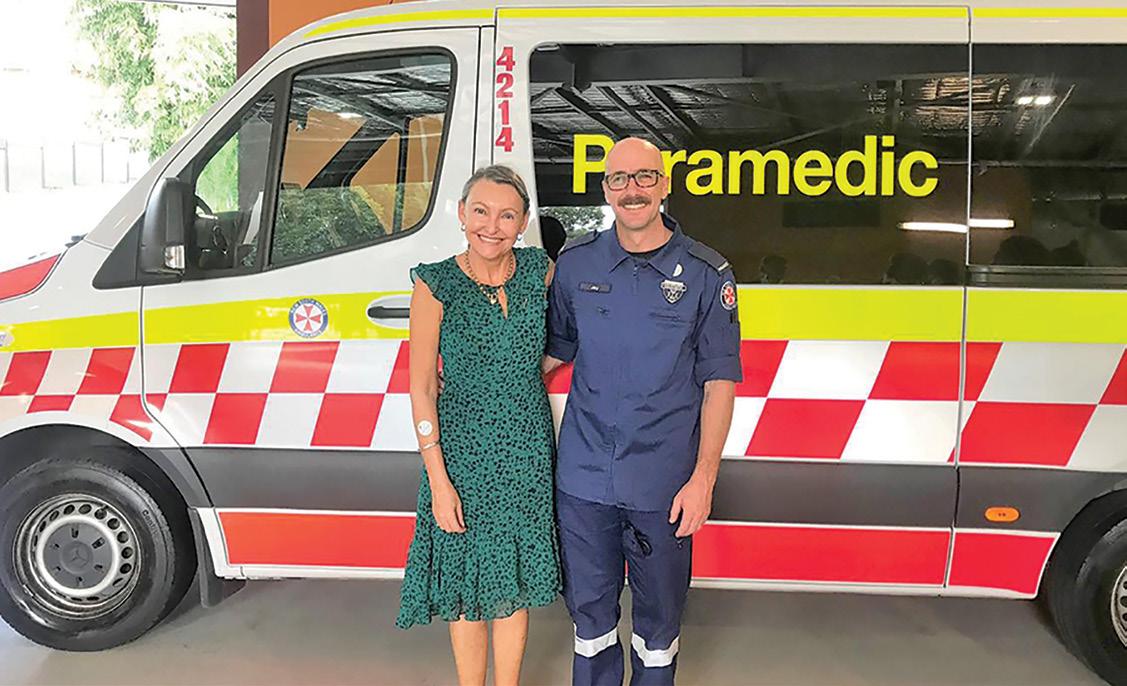


Paramedics speak out after damning report into St John Ambulance NT's governance and culture.


Northern Territory's troubled private ambulance service fear they are “failing their patients” due to poor governance and delayed response times in dangerous situations.
It comes after the leaking of a report that found “serious concerns” within St John Ambulance NT's clinical governance and cast doubt over the organisation's contract with the NT government.
The report recommended St John NT urgently appoint more senior staff, suspend some life-saving procedures and address a “disconnect” between senior management and frontline staff.
Several employees have now told the ABC the report - which found some processes may have led to patient deaths and “significant risk” to staffwas an accurate reflection of what was happening on the ground.
A St John NT paramedic, who was not authorised to speak to the media and spoke to the ABC on the condition of anonymity, said there was “a feeling of lack of trust between operational staff and executive management”.
They said the distrust stemmed from the removal of St John NT's chief medical officer late last year and the resulting “lack of governance structure”.
The paramedic said that had led to “an acceptable level of harm” within the service, something staff were struggling with.
“They feel like they're failing their patients, they feel like they're not responding in appropriate time frames,” they said.
“There's certainly a feeling that there might be less risk accepted in other states.”
The United Workers Union NT, which represents paramedics and ambulance officers, has long called for the service to be de-privatised and brought under government control.
The paramedic echoed those calls, saying the organisation needed “cultural change”.
“People are less likely to report bullying and harassment in their workplace … less likely to report acts of violence in the community against them, because they are not confident anything will be done about it,” they said.
“It just feeds into that mental risk in staff … you're going into extreme conditions, under extreme pressure, and all of that adds to it.”
Richard Brady is a restocking and sales officer who has worked for St John NT for 13 years.
He told the ABC there had been a “remarkable” turnover of staff in the organisation in recent years, which he attributed to a loss of trust and confidence in senior management.
“There's this general feeling with most of the staff that I've worked with where they're
treated with not only with indifference, but with contempt,” Mr Brady said.
“There's been lots of really valuable employees of long service who have left very unhappy and have been damaged.”
Mr Brady said he believed the ambulance service would be better run by the NT government.
“There's never enough funding, and I'm certain that there isn't enough now, but I also am very deeply certain that there's been a tremendous wastage of funds,” he said.
United Workers Union NT secretary Erina Early said the report highlighted concerns the union had held for two decades.
She said it was further evidence the ambulance service was “in crisis” and had to come under government control.
“We deal with a lot of paramedics who are fatigued, who are desperate, they're broken,” Ms Early told ABC Radio Alice Springs.
“They feel there's no value for them, that no-one's listening to them … there's high assaults on them as well.
“We deal with four to five suicidal paramedics a month.”
Ms Early accused both sides of government of “not listening” to a string of damning reports into the ambulance service in recent years.

“Would you allow them to privatise our NT Police Force, privatise our NT fireys, privatise our hospitals?” she said.
“We need accountability, we need to keep our paramedics here in the Northern Territory, we need to ensure they're properly trained.”
St John NT director of ambulance services
Andrew Thomas said the organisation had “openly engaged” with the review and supported staff to raise their concerns during the process.
It came after the report said some staff had been reluctant to raise concerns due to fears of litigation and St John NT's “involvement of lawyers” during the review.
“We encouraged, along with the union, for paramedics to go to [meetings], to have their say and to be free and open in what they said,” Mr Thomas said.
Mr Thomas said St John NT acknowledged the report had raised “concerns for the community and patients”.
“We have made significant improvements in terms of our patient safety and quality areas of the organisation, and that had been going on well before the review commenced,” he said.
Mr Thomas said those improvements included regular reviews of intensive care paramedic cases and improved reporting between NT Health and St John NT.
continuing to review the ambulance service's contract.
With concerns about St John NT's clinical governance emerging, the service has said its paramedics face violence and threats “every other day”.
St John NT territory response manager Craig Garraway said there had been 117 reported incidents since the start of this year.
He also said there had been six incidents across the territory on Wednesday night alone, including one in which a paramedic was threatened with a knife while treating a patient in Palmerston.
In Alice Springs, paramedics had to call for police back-up to two separate incidents of abusive behaviour, which Mr Garraway said delayed their response to a patient suffering a heart attack.
Mr Garraway said St John NT's leadership was currently reviewing how it could “reduce the risk immediately”.
“What we're trying to do is actually stop our paramedics attending some of these cases that are really dangerous and holding back until we can get police to help us,” he said.
“It may be that we've got to send more [St John NT] staff in together.

“It will delay a response to some of these cases.”
In an email sent to all staff on Friday, obtained by the ABC, St John NT announced a range of measures to support staff safety.
The service said it would immediately stop dispatching solo responders and would request that the NT government send transit security officers to all emergency call-outs at bus stops.
St John NT paramedic Bridie Morley said she had faced several dangerous situations in her eight years working in the territory, including “many near-misses” that had left her considering leaving the profession.
“When you've got somebody with a weapon that is threatening to kill you, you drop everything and run,” she said.
“We're not trained for combat and running for your life.”
Mr Edgington said the government hoped new mandatory sentences for assaults on frontline workers would act as a deterrent to attacks on paramedics.
“We need to call out this behaviour now,” he said.
“We need to do everything in our power to stop this behaviour.”
By Annabel Bowles abc.net.au
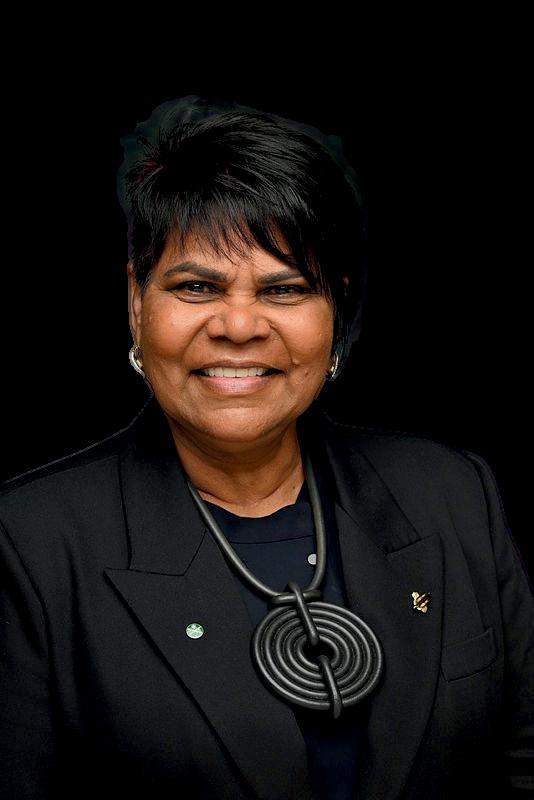

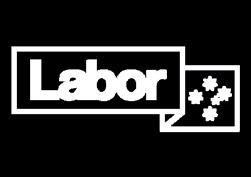

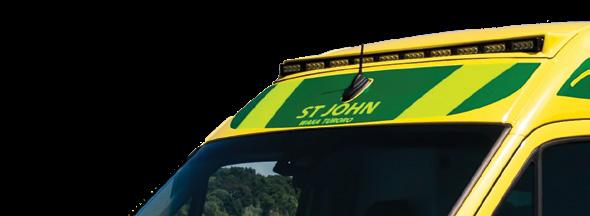

NZCT Grants $150,000 to Fund New Ambulance for Whanganui!
(NZCT) has awarded a $150,000 grant to Hato Hone St John’s Central Region Trust Board which will help fund a new ambulance for Whanganui and surrounding communities.
Hato Hone St John ambulances serve 90% of Kiwis across 97% of the country. Operations Manager Liz Garmey explains, “As a charity, Hato Hone St John relies on the generosity of donors and funders to help us purchase new emergency vehicles and life-saving equipment that our ambulance officers use every day. The total cost of a fully equipped ambulance, including medication and equipment is approximately $325,000. This generous grant from NZCT will go towards funding the second of four new all-wheel drive ambulances we’re purchasing for Whanganui and surrounding communities.”
Garney adds ‘’ Our ambulances are under an increasing amount of strain due to the continual increase in demand for our service. Not only are we attending more incidents every day but also travelling further distances.”
NZCT’s GM of Grants, Marketing and Communications, Ben Hodges, adds, “We’re proud to support Hato Hone St John in Whanganui, and the amazing work they do saving lives. This grant wouldn’t be possible without the responsible gaming partnerships we share with our Whanganui-based venues.” nzct nzct.org.nz
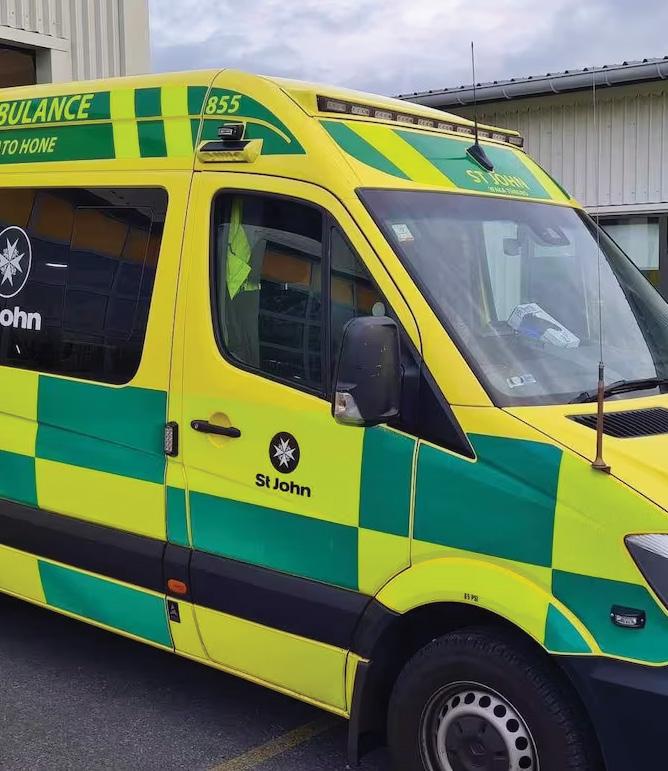



“This
generous grant from NZCT will go towards funding the second of four new allwheel drive ambulances we’re purchasing for Whanganui and surrounding communities.”
Operations Manager Liz Garmey
New ambulance a critical boost for Hato Hone St John’s services in Whanganui.
WHANGANUI IS GETTING A NEW ambulance which will boost Hato Hone St John to provide services under “increasing strain”.
The new vehicle is the second of four all-wheel-drive ambulances that are being bought for Whanganui and the surrounding communities. A $150,000 grant from New Zealand Community Trust (NZCT) will help fund the ambulance.
The total cost of a new, fully-equipped ambulance, including medication and equipment, is about $325,000.
Hato Hone St John operations manager Liz Garmey said the organisation relied on the generosity of donors and funders to be able to buy new emergency vehicles.
“Our ambulances are under an increasing amount of strain due to the continual increase in demand for our service,” Garmey said.
“Not only are we attending more incidents every day but also travelling further distances.”
NZCT is one of the largest gaming societies in New Zealand. In 2023/24, more than $40 million in grants were awarded by the trust through the proceeds of gambling.
NZCT national grants manager Ben Hodges said the trust was proud to support Hato Hone St John in Whanganui.
Whanganui Chronicle nzherald.co.nz
“THE INSIDER CLAIMED 155 JOBS WERE STILL OUTSTANDING ON MONDAY MORNING AND THAT PEOPLE WHO WERE REPORTING CHEST PAINS HAD BEEN TOLD TO GET THEMSELVES TO THE NEAREST HOSPITAL.”
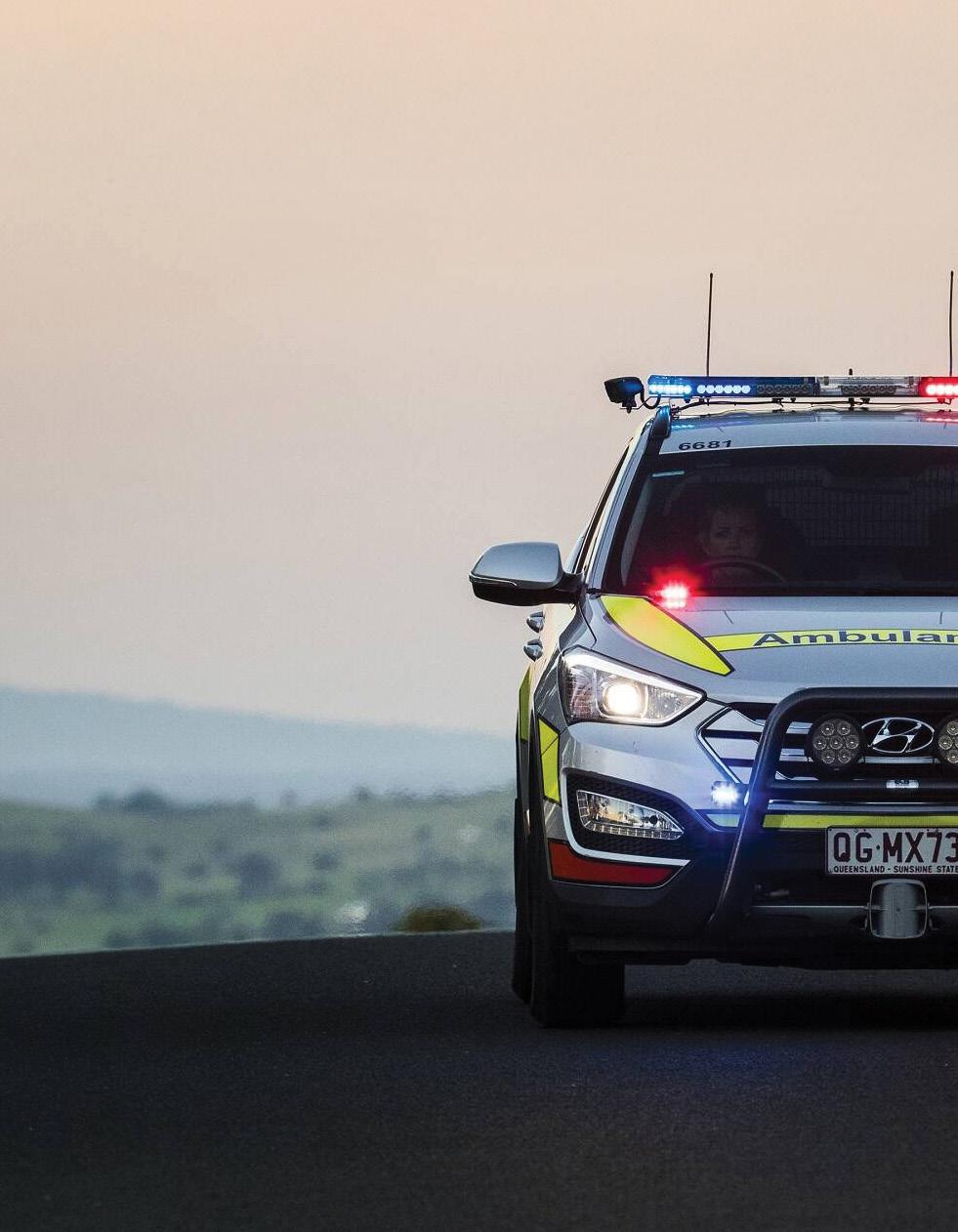

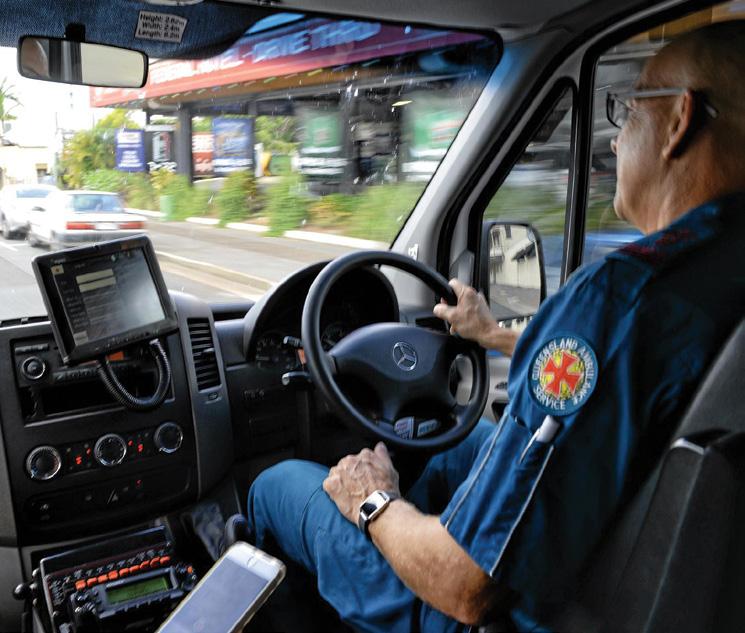
Whistleblower says 188 calls to Queensland Ambulance Service over weekend left pending.
Queensland Ambulance Service were left pending over the weekend, a whistleblower has claimed.
The ambulance insider said there were 188 calls to the QAS that were sourced and then unanswered, meaning they were pending until eventually being cleared. These jobs had a wait time of longer than half an hour.
The insider claimed 155 jobs were still outstanding on Monday morning and that people who were reporting chest pains had been told to get themselves to the nearest hospital.
Responding to the allegation that jobs were left pending, Health Minister Tim Nicholls told Peter Fegan on 4BC Breakfast that the QAS had cancelled non-essential training and offered overtime to the workforce in a bid to meet the surge in call outs.
“Friday and Saturday were big days, there was a big surge of people,” Mr Nicholls said.
“No, it’s not good enough having people there for that long and that’s why we’re working hard to make sure that we’ve got the workforce available to deliver it, that we’re resourcing things properly and that we’re also dealing with that ambulance ramping rate.
“Ambulances are waiting too long after they get to a hospital, after they’ve discharged their patient, to get back onto the road and it’s a mighty task.”
While Mr Nicholls said there had been improvements to the ambulance ramping rate, he conceded there was work to do to improve ambulance ramping and responses.
“It’s been an issue for many years now, and that’s why we’re, you know, resolutely focused on the ramping rate and getting that down,” he said.
“We’ve had some progress there the last quarterly figures, or the last monthly figures, I should say that we released showed we got that down by 4 per cent more.
“There is work to do, obviously, and also ensuring that people who are calling an ambulance are not waiting longer in the community than they should.”
Responding to the suggestion that some members of the public with chest pains were told to get themselves to hospital, Mr Nicholls said that all patients were managed and prioritised by the health service depending on the severity of their condition.
“We manage it in a number of ways, but the most critical patients, the 1As,

the lights and sirens, are absolutely prioritised,” he said.
“So if you’re a 1A patient lights and sirens, immediate priority, immediate dispatch, but if you’re a lesser priority, the clinical hub will monitor that, and that will be the doctors and nurses in the clinical hub, and if the position of the patient worsens, then they are elevated up the priority list.
“Sometimes they will say, if you can get yourself to the emergency department, if someone, if a relative’s at home, someone can drive you there, make sure they do that.
“As I say, not good enough, we need to work harder at it.”
A Queensland Ambulance Service spokesman on Tuesday said there was a surge of calls for people not requiring a Code 1A response over the weekend.
“From Friday night through to Saturday, the QAS did experience a period of surge where a number of patients not requiring a Code 1A response waited for an ambulance,” the spokesman said.
“For context, the average number of Triple Zero (000) calls during March is 3300, with Friday experiencing a surge of over 3700 (+400).
“During this time, clinical oversight was provided by the Clinical Hub who provided safe advice to patients. Should the condition of the patient change while
waiting for an ambulance, the clinician will upgrade the priority of the request.”
The spokesman added that QAS will always prioritise people who make Triple Zero calls.
“The QAS will always provide services to the community who access Triple Zero (000),” the spokesman added.
“Patients who are critically unwell are classified as a Code 1A, and an ambulance is dispatched as a priority.
“For patients who don’t have a critical injury or illness, responses will be prioritised according to their clinical condition.
“Should an ambulance dispatch be required, and the health system is experiencing surge, patients are kept safe utilising the QAS Clinical Hub.
“The Clinical Hub is a multi-disciplinary team of health professionals that provide virtual care to patients who have accessed Triple Zero (000).
“This team provide high level clinical advice and treatment as required, and also provide alternative pathways to suitable patients who may be better treated through other means than an emergency department.”
The QAS encourages the community to continue to call Triple Zero (000) in an emergency.
For non-urgent concerns, 13 HEALTH is available 24 hours a day for advice.
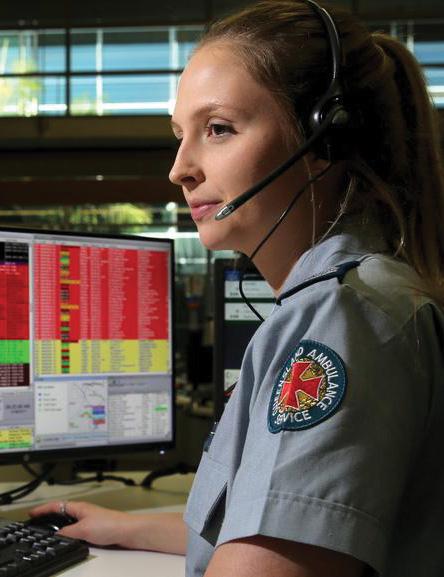
United Workers Union members stretched to the limit. The ongoing strain on the system is just further proof of the funding needed to resource this essential service. Forecast demand growth and improvements to workplace health and safety measures means many more positions will need to be funded to even keep pace.
Fiona Scalon
National Ambulance Coordinator United Workers Union
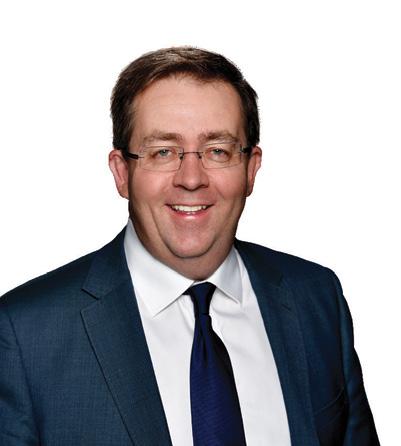








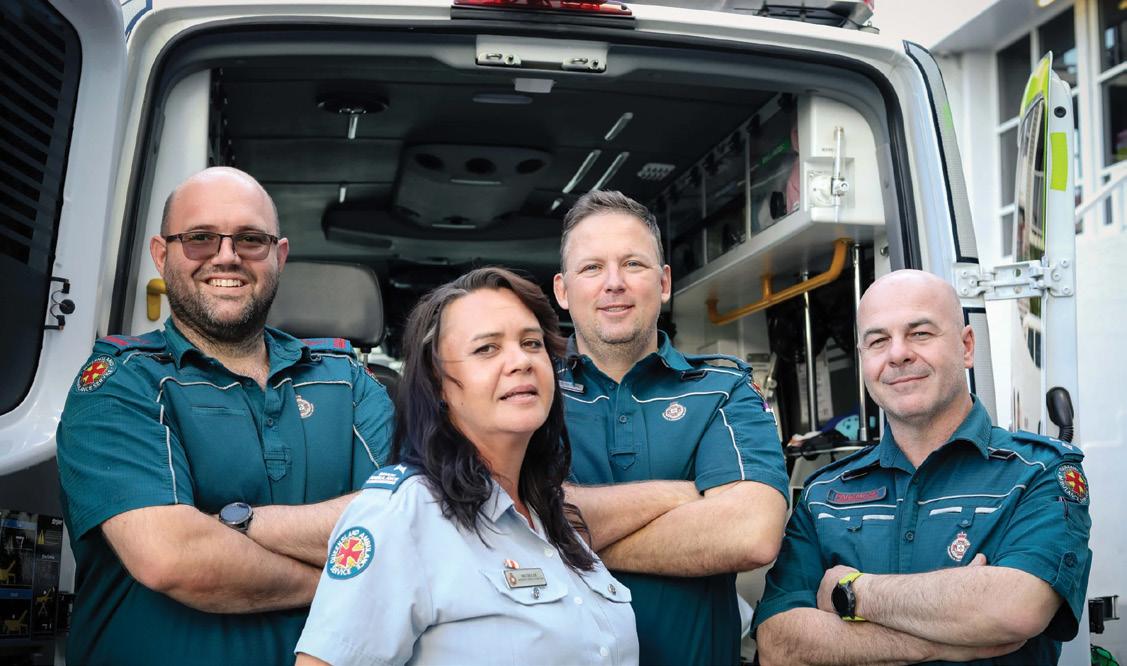
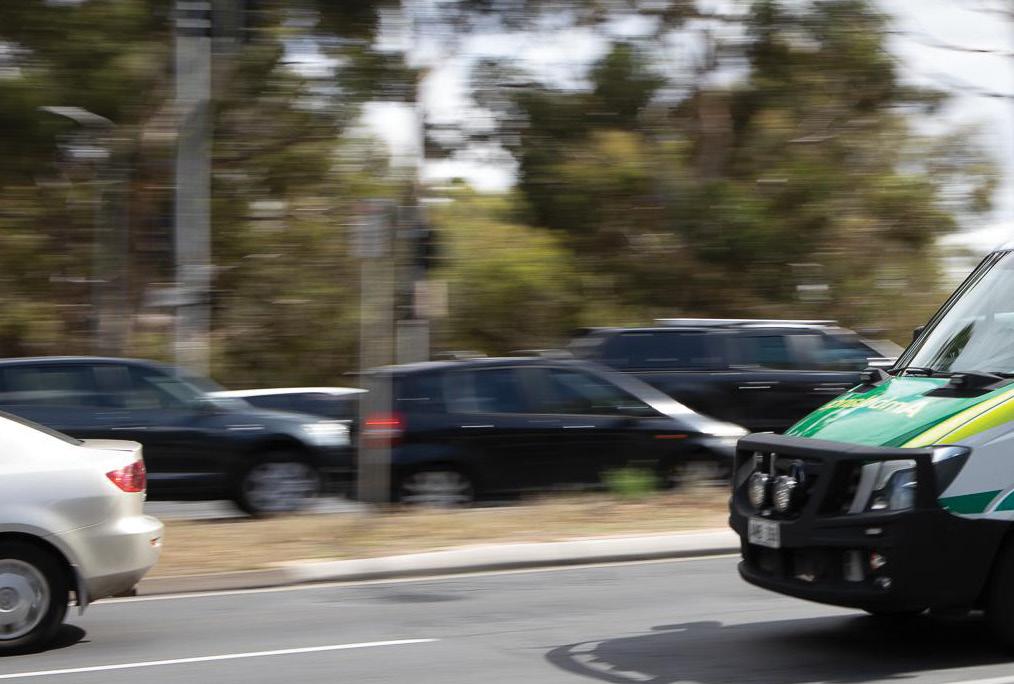
The ambulance union has hotly rejected Liberals claims moves to speed up offloading patients will result in a “dump and run” situation, calling it offensive.
THE AMBULANCE UNION HAS welcomed an updated handover policy which it says has an “emphasis on finding a safe place for offload of ambulance patients to free up ambulances” but savaged the opposition’s claim it will result in a “dump and run” attitude by paramedics.
SA Health’s updated Ambulance Transport and Handover policy puts the onus firmly on hospitals to take responsibility for ambulance patients once they are triaged on arrival with the expectation they will “moved from the ambulance to an appropriate place in the hospital as soon as possible.”
This has raised concern among clinicians it will see patients queued in corridors in busy times to free up ambulances.
Ambulance Employees Association state secretary Paul Ekkelboom welcomed the clarification that hospitals have responsibility for patients once they arrive at ED, and its emphasis on finding a safe place to offload ambulance patients so ambulances can respond to the community.
He noted the AEA rejects the “offensive suggestion” made by the opposition health spokeswoman Ashton Hurn that paramedics will “dump” patients
at hospitals and “run, “stressing that ambulances officers will always act in the best interests of their patients and will never put patients at risk of harm.
“The emphasis on offloading ambulance patients into hospital EDs, where it’s clinically appropriate to do so, is timely recognition of the dangers of external ramping to the South Australian community,” he said.
“The distinction between a patient waiting inside the hospital or outside the hospital might seem slight but it is important: if patients can safely wait inside hospitals rather than on the ramp, ambulances are freed up to respond to the community.
“The patient most at risk is not the patient in the hospital ward or in the hospital ED. It’s not even the patient in the hospital corridor or the patient ramped in the back of an ambulance.
“It’s the patient out in the community who has called triple-0, who hasn’t been assessed or accessed care, and who an ambulance can’t get to – because it’s stuck on the ramp.”
SA Health chief executive Dr Robyn Lawrence said the 2024 Ambulance Ramping Report by Professor Keith McNeil and Dr Bill Griggs, identified
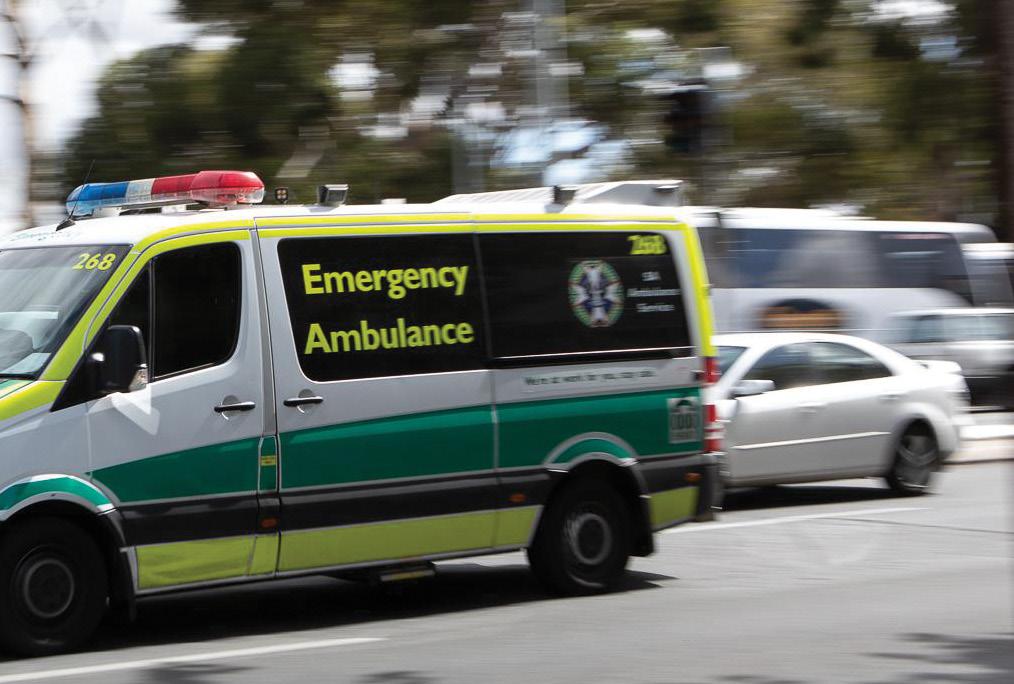
ambiguity regarding who has legal responsibility for patients.
She said as a result, SA Health sought to clarify the policy by clearly detailing when legal responsibility transfers from the SA Ambulance Service to the hospital.
“Under this policy, transfer of legal responsibility occurs at triage,” she said. “This is a separate issue to transfer of care, which occurs when the patient is clinically handed over and physically transferred from paramedic to the receiving clinician to continue to receive clinical care. This will continue to occur as normal, and no change to this existing practice has been proposed.”
A government spokesperson said: “There is no change to how or where patients are treated and it is false to suggest otherwise. It’s false for Ashton Hurn to claim otherwise.
“SA Health existing policy requires patients to be treated in a hospital as soon as possible and that remains the case.
“Ashton Hurn must explain why she does not support the findings of the expert review.”
By Brad Crouch



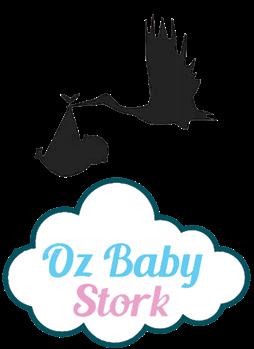
Budget Roo Global can ship products all around the world. On average small products can be shipped to you within 1530 days and large products 30-60 days. https://budget-roo.com/
Budget Roo Australia (Camping Supplies) ships to Australian customers. On average all products can be shipped to you within 7-15 days Australia wide. https://budgetroo.com.au/
Oz Baby Stork (Baby Care) ships to Australian customers. On average all products can be shipped to you within 7-15 days Australia wide. https://ozbabystork.com.au/
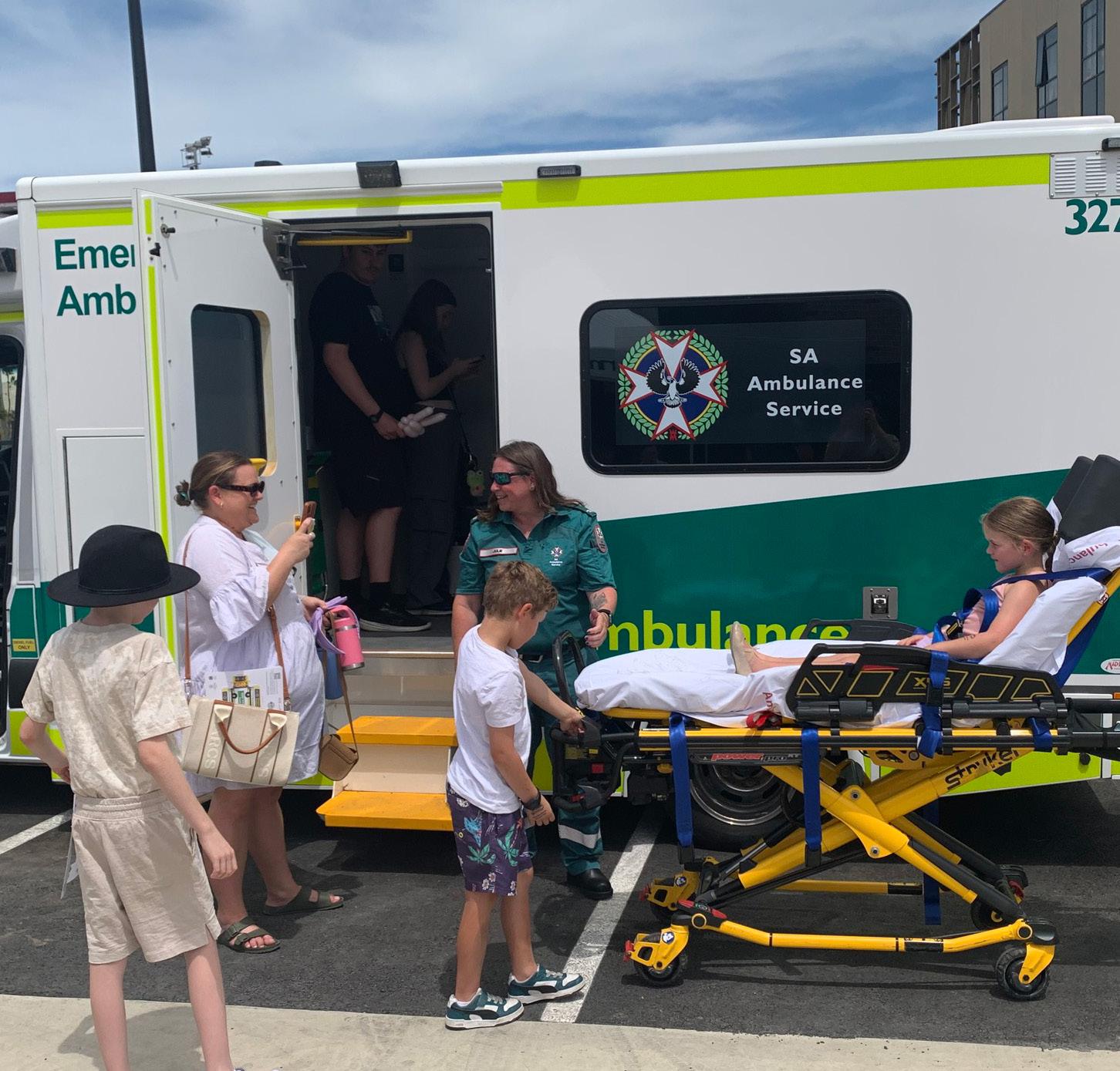
The AEA was excited to celebrate two huge milestones in the last couple of weeks with the opening of the brand-new Mount Barker and Golden Grove Ambulance Stations.
THE OPENING OF THESE NEW STATIONS WILL SEE A much needed additional 50 staff on road in these communities.
The AEA acknowledges the hard work of its members who fought to secure a safe level of ambulance resourcing. It's rewarding to now see the results of their advocacy and we know they are thrilled to be able to properly service their growing communities.
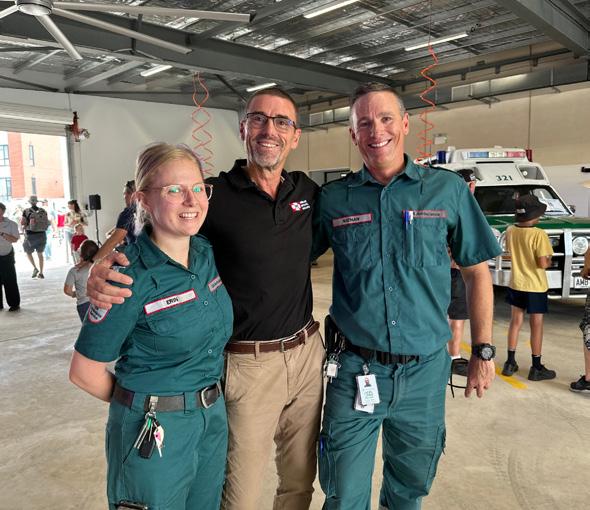
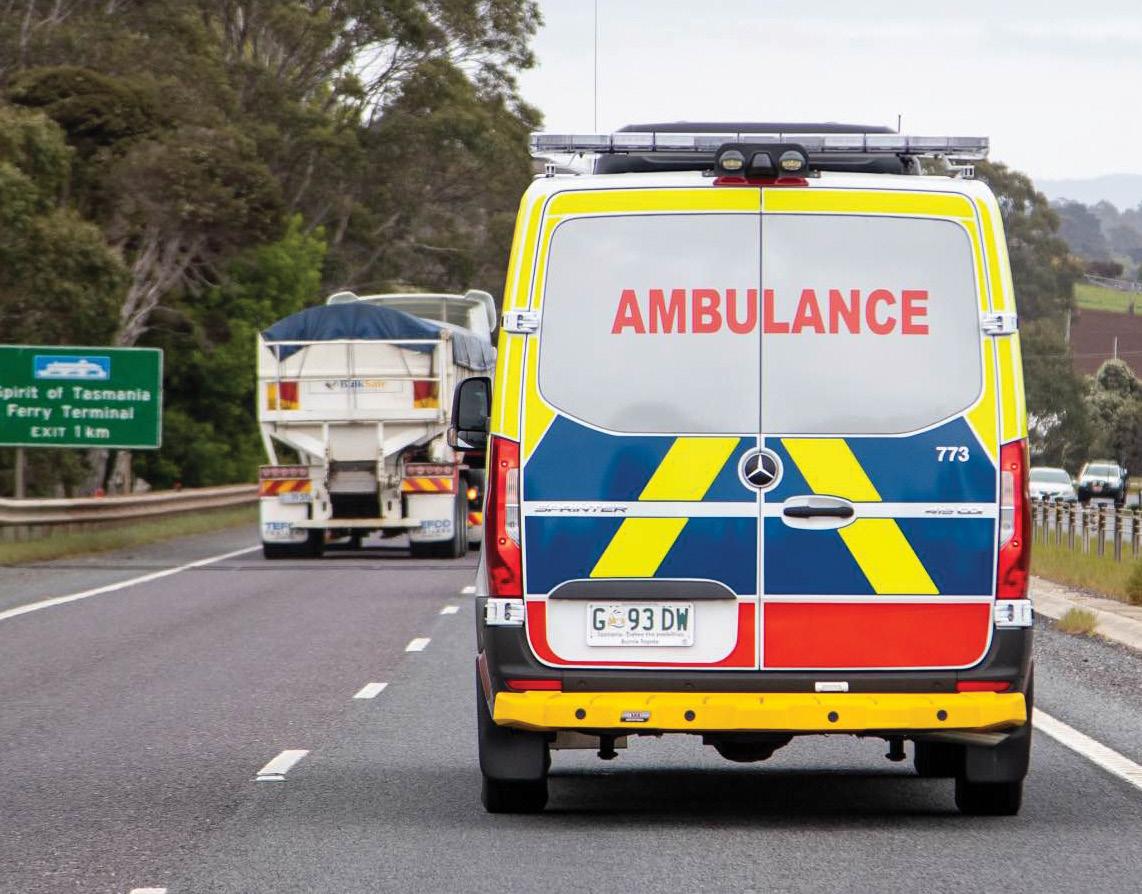
Ambulance Tasmania staff take industrial action over ‘critical’ triple-zero gaps.
AMBULANCE TASMANIA STAFF ARE taking industrial action over “critical” understaffing issues that have left emergency call centres without operators at times.
The Health and Community Services Union (HACSU) says the shortages have been so severe that both long and shortterm vacancies have meant all triple-zero call taker positions on the roster have been empty for certain shifts.
“Staff are extremely angry at the current circumstances which Ambulance Tasmania don’t appear to consider serious,” HACSU delegate Becc Gibson said.
“Last week we asked for an urgent meeting and were told to wait until 12 December. Our members are exhausted and sick and tired of being treated this way.”
According to the union, management has “exploited” the goodwill of employees
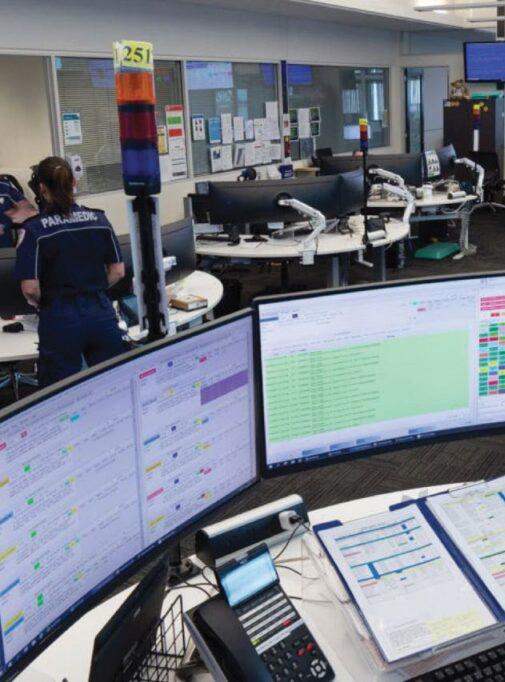
who have adjusted their shifts at short notice to cover shortages and withdrawn an arrangement to compensate staff for these changes.
An Ambulance Tasmania spokesperson disputed this, saying senior leadership met with the union on Friday where they were told overtime payments had not been withdrawn.
“Ambulance Tasmania (AT) acknowledges and appreciates the hard work and commitment of staff in the communications centre and all staff across AT,” they said.
“AT will continue to negotiate with staff around overtime payments when asking staff to change either shift start and finish times.”
Ambulance Tasmania will next meet with the union on Thursday.
“AT continues to actively recruit to vacancies, noting that this is a specialised
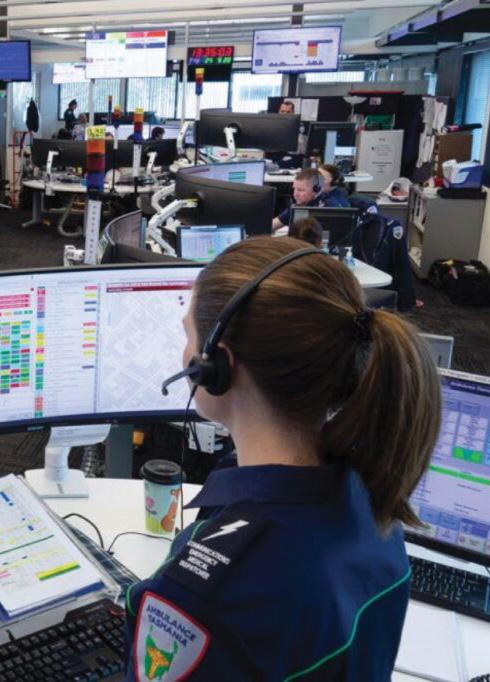

field and that other ambulance services across the country are also having difficulty in recruiting in this area,” the spokesperson said.
HACSU state secretary Robbie Moore said the action will not affect any triplezero responses from the ambulance communications centre.
“The action relates to the process management will need to implement to seek approval for short-term shift changes and how our members should be compensated,” he said.
“Additional bans have been implemented today to remove additional workload from communications centre staff until this dispute is resolved.”
By
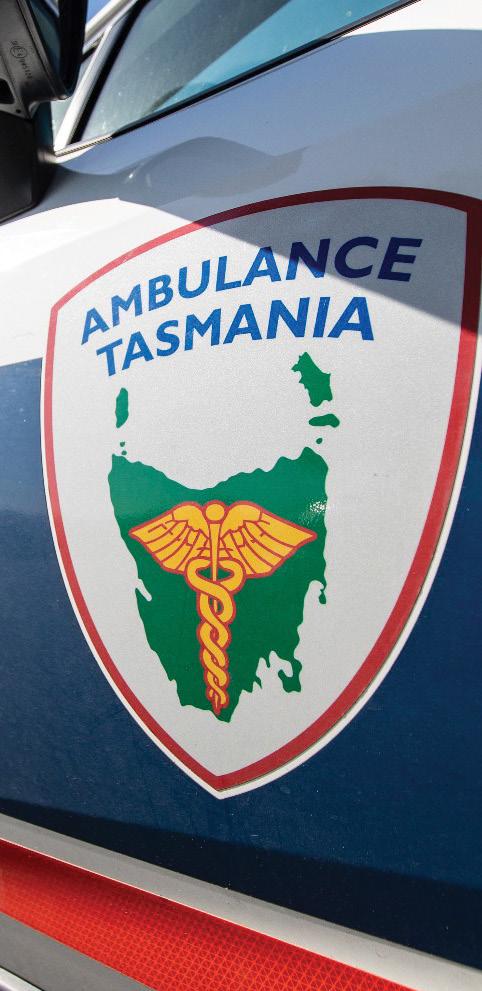


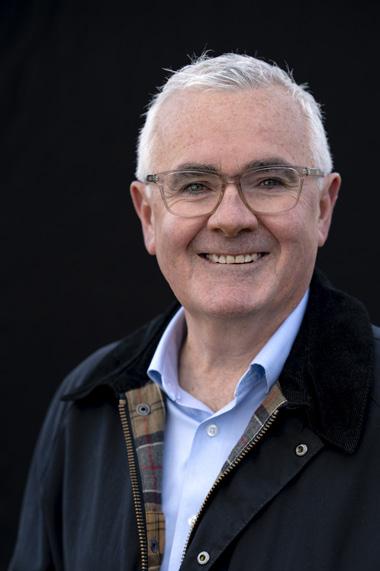
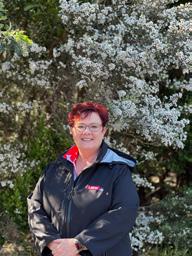
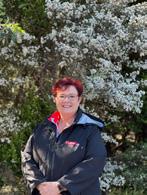


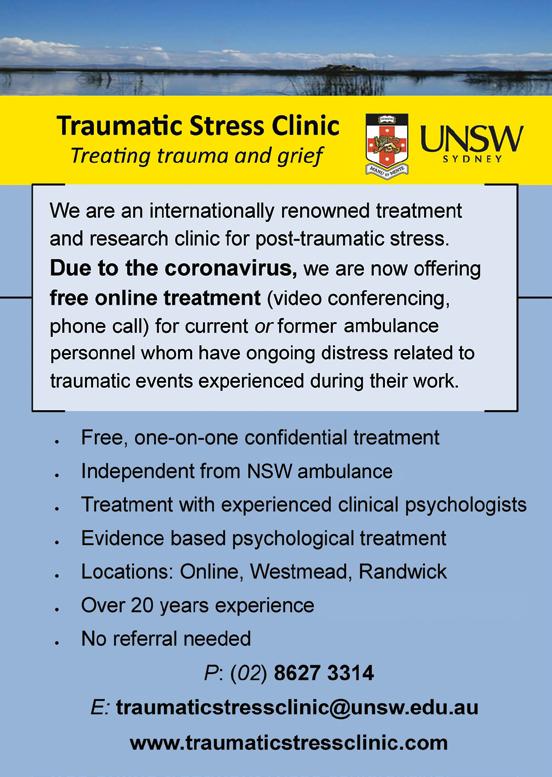

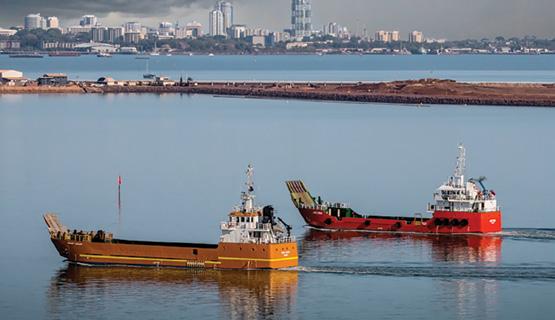
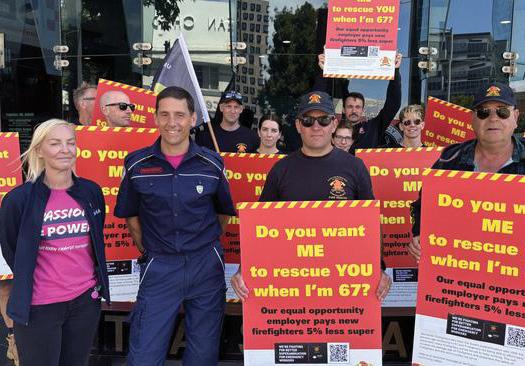
“THE UNITED FIREFIGHTERS UNION OF Australia Tasmania Branch (UFU) and the Health and Community Services Union Tasmania Branch (HACSU) have commissioned the Australia Institute to examine superannuation shortfalls impacting firefighters and paramedics in Tasmania.
“Simulations published today by the Australia Institute’s Centre for Future Work demonstrate that the majority firefighters and paramedics entering the workforce right now will not have enough superannuation to retire with the same level of financial security as other workers.
“All workers need to reduce their living expenses when they retire, but firefighters and paramedics would need to reduce their retirement living expenses by a further 18.5% in order for just half of emergency service workers to avoid having their superannuation run out during their lifetime.
“Under relatively optimistic assumptions firefighters and paramedics will run
out of superannuation 6 to 10 years before their life expectancy.
“When considering financial risk factors, it becomes much worse, particularly for women, those who do not own their own home, or if there are changes in superannuation investment returns, or tax policy.
“Firefighters and paramedics undertake physical work in difficult circumstances, sometimes with a life depending on them.
After 60, most firefighters and paramedics don’t feel they can perform as well as they used to and retire early for the safety of the community and their colleagues.
“Professionals who spend their career serving the community often retire early at the expense of their own financial security.
“It’s already difficult for people over 60 to find work, but the extreme specialisation of skills makes it almost impossible to find other work with similar pay. There aren’t many employers looking to hire older workers with qualifications focused on fire suppression and rescue disciplines.
“Early retirement impacts superannuation balances in a number of ways. You miss out on 7 years of superannuation contributions, the interest in the final years is reduced as you have to dip into the balance earlier, and it has to cover an additional 7 years of life expectancy.
“We have a superannuation system that punishes firefighters, paramedics and their families by ensuring that the vast majority of these workers will not have enough superannuation to support them in retirement.
“We call on the state and federal government to urgently take action to rectify this emerging issue before it becomes a crisis.
Stephen McCallum, Industrial Organiser, United Firefighters Union of Australia Tasmania Branch
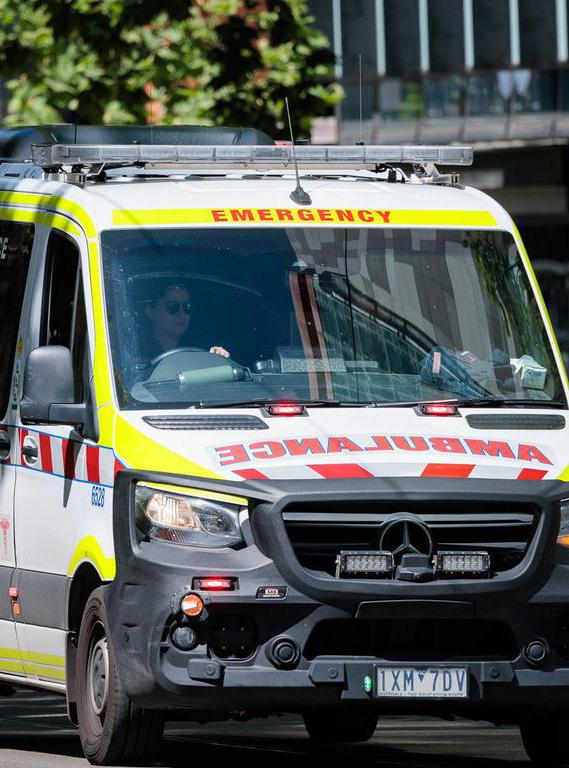
Chronic staff shortages spark crisis talks at Ambulance Victoria.
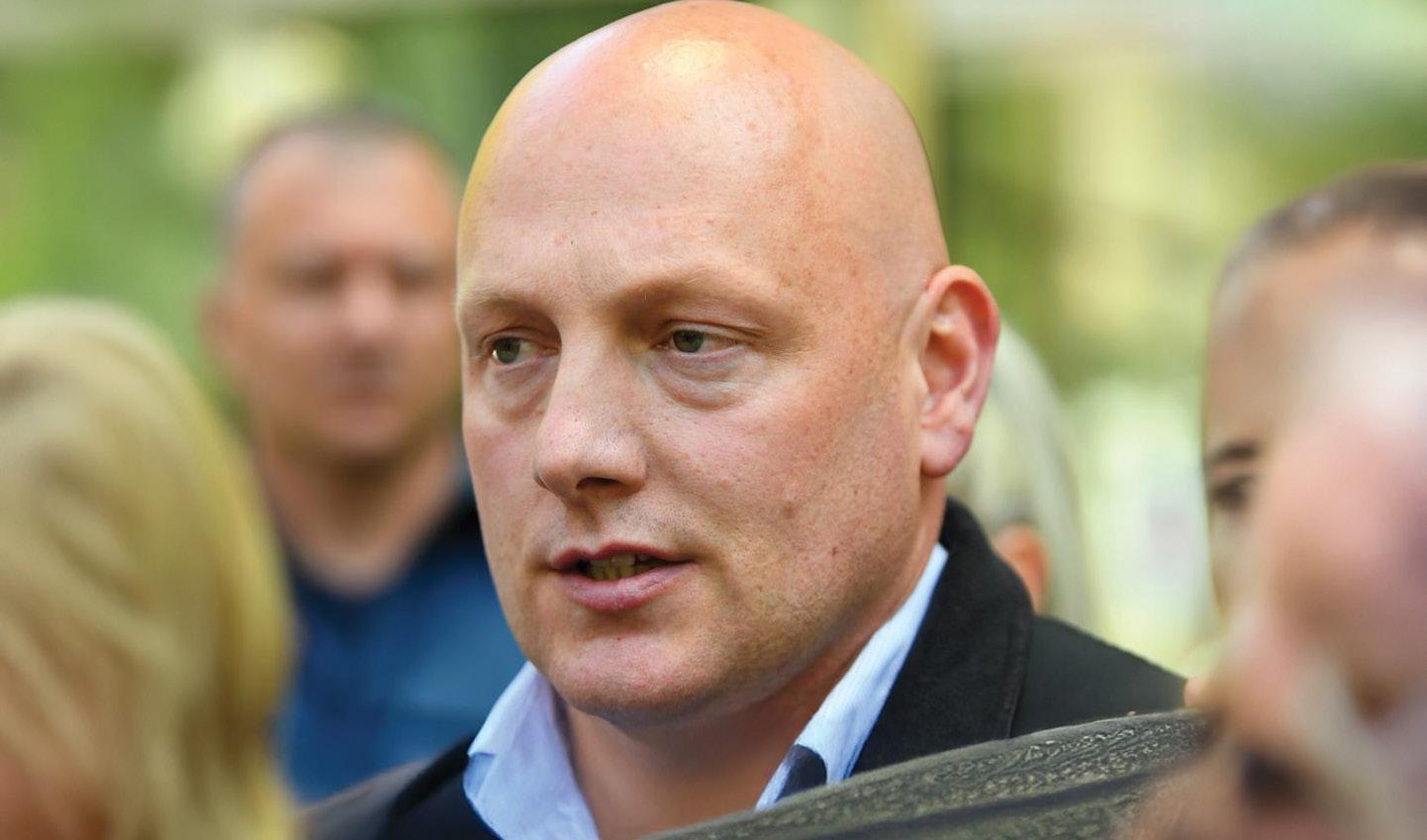
AMBULANCE VICTORIA EXECUTIVES will hold crisis talks about ongoing resourcing issues, after one third of the service’s metropolitan fleet was rendered out of action on Saturday night when dozens of staff called in sick.
Ambulances are sitting empty because of chronic staff shortages sparking urgent crisis talks within the embattled emergency service agency.
Ambulance Victoria executives will on Wednesday hold an emergency meeting about how to manage ongoing resourcing issues that are keeping ambulances off the road.
It comes after one third of the service’s metropolitan fleet was rendered out of action on Saturday night after dozens of staff called in sick.
Other vehicles operated as single officer crews meaning they couldn’t transport patients.
And there were no specialist MICA paramedics available in the entire Geelong region.
Ambulance Victoria published a rare alert on Saturday amid fears the chronic shortages would lead to critical delays.
Senior Ambulance Victoria sources said an ongoing staffing issue had seen more than 300 staff call in sick during one recent 24-hour period.
Concerns have been raised about a “rolled-in rate” paid to paramedics that covers all allowances and penalties as part of their base pay.
But sources say the model fails to incentivise paramedics from turning up to work during shift times including Saturday nights.
Questions have also been raised about the agency’s new rostering system and its ability to ensure shifts are properly filled.
Ambulance union secretary, Danny Hill, said changes were needed to address the ongoing issue.
“Absences due to sick leave, workplace injury and burnout are often high, but Saturday nights are always worse because they are so busy,” he said.
“That in turn makes vacant shifts harder to fill with paramedics working overtime.
“Members on flexible work arrangements have been pleading to have access to shorter night shifts on Fridays and weekends, so that they can increase weekend coverage as part of their regular hours.
“But this has been refused for years. AV have only started trialling them this year.”
Mr Hill said burnout from an “evergrowing workload” was also contributing to chronic shortages.
“Until that is fixed, AV is always going to have problems filling shifts, especially the busiest weekend shifts.”
Ambulance Victoria Executive Director, Regional Operations, Danielle North rejected suggestions the new rostering system was impacting operations.
“Our paramedics, first responders and communications centre staff provide
exceptional care and support to the community – and Saturday night during hot and busy conditions – was no different, despite the surge in demand,” she said.
“We initiated our surge protocols on Saturday due to unplanned personal leave, high predicted visitor traffic in city due to major events and the impact of heat. These were clearly communicated.”
Opposition health spokesperson, Georgie Crozier said she blamed Labor for≈an ongoing ambulance crisis.
“Dozens of ambulances not available for emergencies is putting the lives of Victorians at risk,” she said.
“The government must urgently address this failure to ensure that Victorians can get emergency care when they need it.”
Health Minister Mary-Anne Thomas on Wednesday said she expected Ambulance Victoria to review its rostering arrangements to ensure Saturday night’s chaos did not occur again.
She said operational executives would meet to “put in place strategies to reduce the occurrence in the future”.
“We had record crowds at the Grand Prix, footy was back and we had really hot weather, so plans were put in place,” she said.
“We also had to manage some unplanned absences.”
“Once it became aware that there were a number of crews not going to be on duty, normal surge processes were put in place,” Thomas said.
Every day you provide essential support and expertise to people who are in need, distressed, or at their most vulnerable. You provide first response critical care, and your work saves and changes lives. Thank you for the dignity, respect and care you bring, every day, in so many ways.


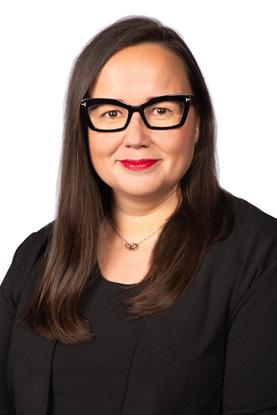
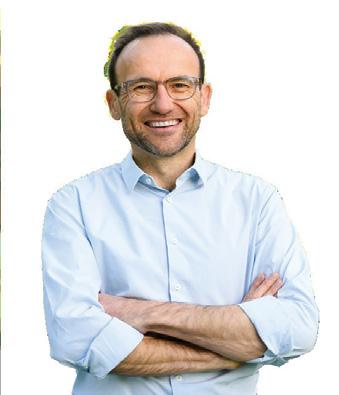
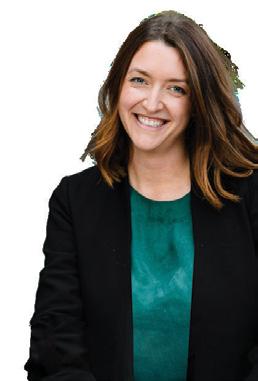

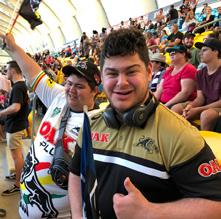
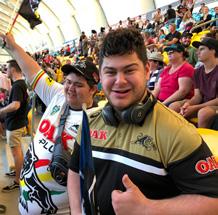
Your NDIS registered provider for all your social and recreational activities!
Your NDIS registered provider for all your social and recreational activities!
We provide exciting adventure outings, relaxing getaways, and recreational holidays for people living with a disability. Get in contact with our team to discuss how we can support you.
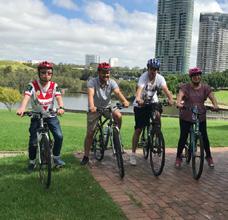

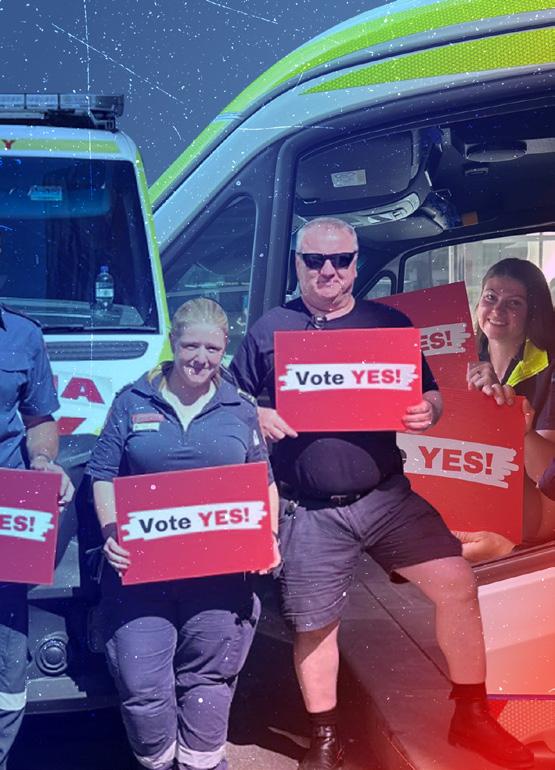

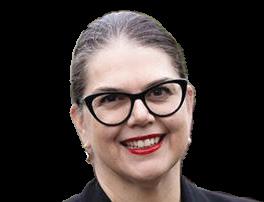
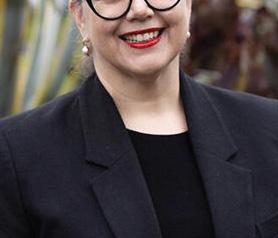
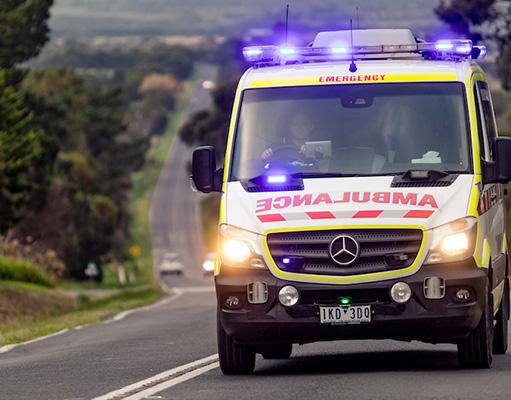
executive officer Jane Miller has resigned from the service weeks after its workers called for a change in leadership.
Her resignation comes less than a month after 97.8 per cent of Victorian Ambulance Union members backed a no confidence vote, calling for a change in management.
The union says the vote was called after members sounded the alarm over “low morale” and an “increasing and unsustainable workload”.
They say these concerns were highlighted when a paramedic crashed an ambulance after claiming to work a shift lasting more than 18 hours.
This vote was separate to ongoing EBA negotiations between Ambulance Victoria and the Victorian government, which have resulted in industrial action.
The emergency service's operations will also be put under the microscope after Victoria's upper house voted in favour of an inquiry last week.
The inquiry will investigate the emergency service's performance and culture, including an alleged embezzlement scandal where six employees were suspended over allegations of serious misconduct.
In a statement, Ambulance Victoria board chair Shelly Park said Ms Miller joined the organisation in January 2023, when Victoria was recovering from the height of the COVID-19 pandemic.
“Jane has seen the organisation through some significant challenges, including leading the post-pandemic recovery, and helping chart a course for ongoing cultural reform and improvement,” she said.
Ms Miller is leaving the role to pursue a new opportunity within the state's health sector.
Former emergency management commissioner Andrew Crisp has been appointed the interim CEO while the service recruits for the role.
Victorian Ambulance Union general secretary Danny Hill said “this is the first step in the right direction”.
“We welcome the appointment of Andrew Crisp, who has decades of emergency service experience,” he said.
“However, there is no time to waste in addressing the concerns that our members have been raising for several years and resolving our 18-month dispute.”
Victorian Health Minister Mary-Anne Thomas said the priority for Ambulance Victoria management should be to resolve the EBA.
“No one wants to see our hard-working paramedics working excessive overtime.”




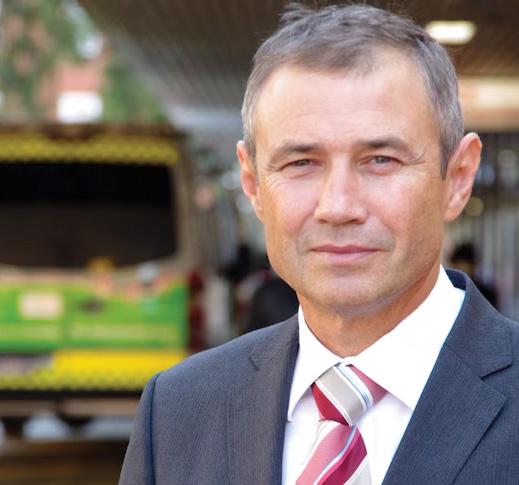
Premier defends ‘nation’s best’ ambulance response times in the wake of Perth father’s death.
PREMIER ROGER COOK SAYS “NO health system is perfect” as he denied ramping was to blame for a Perth father’s death after a 27-minute wait for an ambulance, but vowed his family will be provided answers.
St John WA has identified the 39-yearold’s death after a cardiac arrest as a potential Severity Assessment Code 1, which is when serious harm or death is attributable to healthcare provided.
“No health system is perfect,” Mr Cook said.
“But our ambulance response times are the best in the country, and we’ll continue to make sure that we have improvements.
“When you see a situation where someone’s had a negative outcome
in terms of their clinical care, you investigate, you find answers, you make sure it doesn’t happen again.”
St John WA has a target of reaching 90 per cent of priority one emergency calls within 15 minutes.
On Monday, that target was missed with a 78 per cent metro response rate.
But Mr Cook cited a recent Productivity Commission report on Government Servicesthat ranked WA’s ambulance service the best of all States, with a median response time of 9.9 minutesas proof response times have improved.
“We don’t always get it right, it doesn’t always happen perfectly, but we know that our ambulance response times are the best in the country,” Mr Cook said.
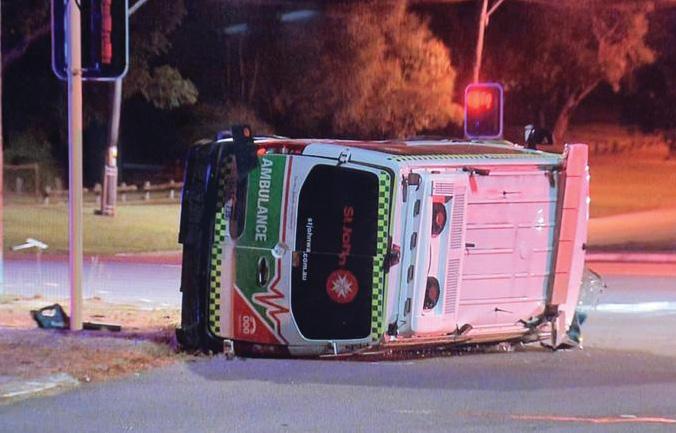
Paramedics escape injury after St John ambulance collides with Mercedes-Benz on Wanneroo Road.
A PAIR OF PARAMEDICS HAVE escaped injury after their ambulance rolled in a crash while responding to an emergency overnight.
Police are investigating the collision — between an ambulance and a MercedesBenz sedan— at the intersection of Beach and Wanneroo Roads about 11.55pm on Thursday.
“The impact of the collision caused the ambulance to roll onto its side”, a police spokeswoman said.
“The 25-year-old female driver of the St John Ambulance vehicle and a 26-yearold male passenger were uninjured.”
It is reported they were taken to hospital as a precaution.
Police said no patients were in the ambulance at the time. The driver of the Mercedes, a 53-year-old man, was also uninjured.
A St John WA spokeswoman confirmed the paramedics were travelling to a priority one job under lights and sirens before the crash.
Another crew was subsequently dispatched to the job.
St John WA sent additional crews to the crash, with police now investigating the incident.



volunteer crew member, and the State Emergency shared her story to conversations among workers and nationwide.
SES uniform at 18 years old, immediately Eleven years on, she’s responded to floods and fires, and at times felt their mental wellbeing. disaster you’re devastation is in front of community, getting people return home, quite process and

paged to another scared to admit for months.”
“After a deployment in 2022, putting my uniform back paged to another job. I was scared to admit it to anyone, for months.”
Ashleigh says she she believed that was worried I had because I’d reached I couldn’t keep A colleague of took the time to
“One day my controller He said ‘I don’t probably do, but don’t have the in and see how
“Him starting that wasn’t giving myself took the weight failing as an emergency of support, and

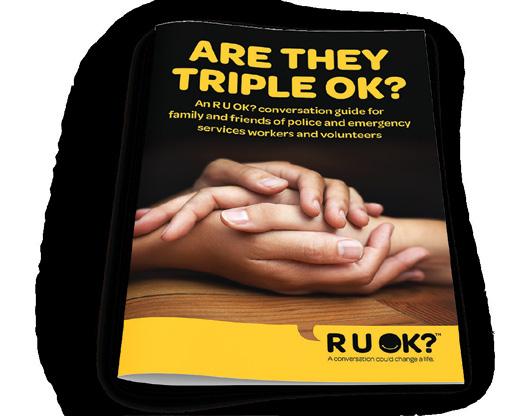
Ashleigh says she internalised she believed that to do her resources

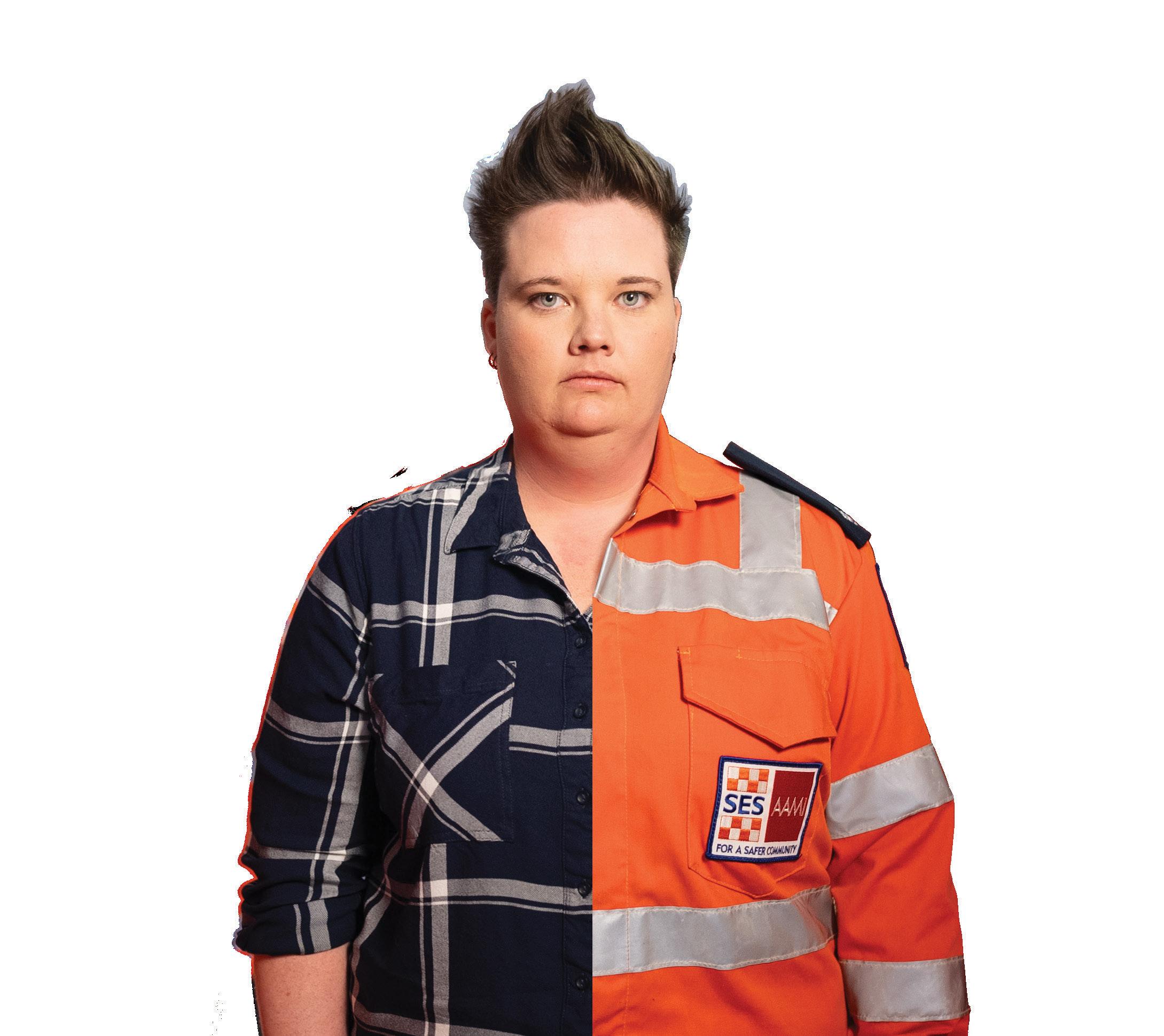




Ashleigh wants everyone to understand the power of having an R U OK? conversation.
“Without that conversation I wouldn’t be in my uniform anymore, I wouldn’t be where I am today. I now know I don’t have to go it alone and I can bounce back stronger.”

“If you notice someone isn’t themselves, trust your gut and check in. Most importantly, make sure you have enough time to really hear their concerns if they say they aren’t OK. It changed my life, and it could change theirs.” along with the free resources for police and emergency services workers and volunteers, as well as their family and friends. These include a conversation guide, a podcast and other personal stories.

If you’re worried about someone, encourage them to contact their Employee Assistance Program (EAP), agency support service or connect with their GP.





ruok.org.au police and emergency services their family and friends. These podcast and other personal stories. them to contact their Employee Assistance Program their GP. 14. Text support is also available:

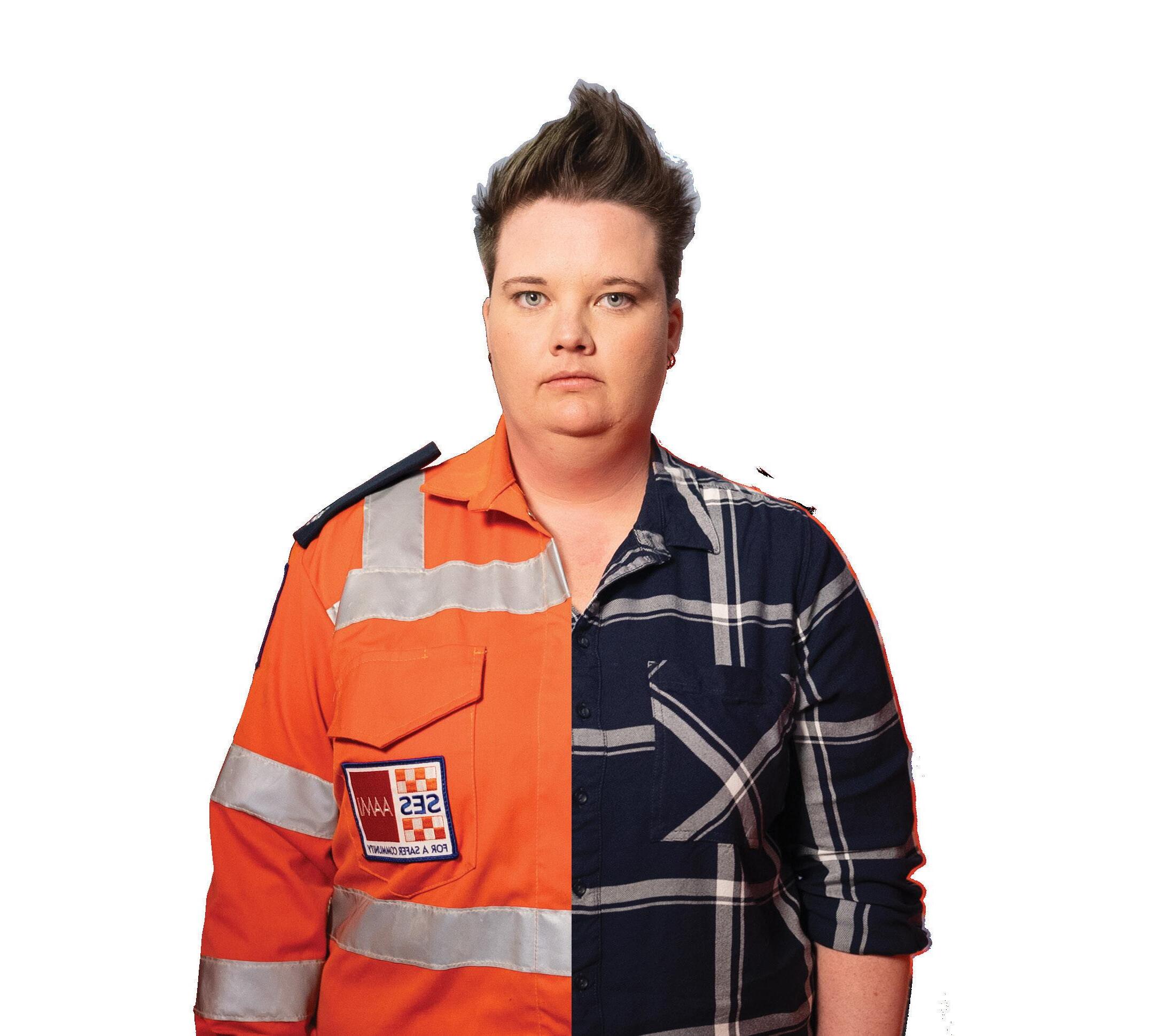


Over 60 years ago, the Pharmacy Guild of Australia launched Guild Insurance – designed to protect and safeguard the pharmacy profession. Since then Guild has expanded the network of professionals we protect by forming partnerships with associations who represent a wide range of industries and the professionals who work within these fields.
Proudly partnering with the Australasian College of Paramedicine for over 5 years means we understand the importance of protecting you with more than just a policy.
With us, you’ll be shielded by a policy created from unmatched insight into your profession, access to risk management materials to help you reduce the risk of a claim, backing
from the industry body that stands up for Australian paramedics, and so much more.
Find out how you can be part of something bigger by visiting: guildne.ws/active or calling 1800 810 213 today.